
My March on Instagram
My private #SciCommChall for March was to start a science communication Instagram account, fascinocean_kiel. I had a pretty clear idea of where I wanted to go with this account:
- The target group are people who live close to Kiel fjord who I want to talk to about oceanographic phenomena you can spot when walking along Kiel fjord
- For that, I wanted to post daily pictures of whatever is going on that day, plus short explanations in German
- I wanted to do this as a proof of concept, to get an idea of the amount of work involved, and to get a feel for how many people you can reach organically with this kind of content; basically to build my portfolio as a science communicator.
This post is for all of you who are curious about
a) how that has been going (I will reflect on that below); or
b) what I have actually done on Instagram, since you don’t actually use the app.
So here we go! :-)
a) How Instagram is working for me (or, at least, the first couple of weeks)
My first impression after four weeks on Instagram: It’s fun! I thought it would be less work than writing a blogpost, but it’s actually not, it is just different. I have to take and select pictures a lot more carefully, crop them, sometimes put a filter on or something (except the green lakes — those were 100% real!), but now I have to think about relevant hashtags so people can find my posts…
And social media are really that, social. Through Instagram, I have connected with a lot of people who I only met through Instagram: On my very first day actively posting on Instagram, I have received an invitation to visit something really cool (will let you know when it’s not a big secret any more). Then, several people who I didn’t know before, messaged me to tell me they liked my “feed”. And then I got recommended for an interview about scientists and social media by someone I don’t even know! I am very impressed with the community on Instagram. And connection also works the other way round: I have found amazing science communicators on Instagram whose posts I look forward to reading every day, for example stories.of.a.scientist, science.sam, bakingsciencetraveller, and sci_wilson, just to name a few.
As for how many people I’ve been reaching (after less than a month on Instagram!): A picture typically get 30-40 “likes”. My best picture currently has 87 likes, but that’s a really awesome picture if I say so myself (see below). I think this picture performed so well for two reasons: because it’s a really cool picture, but also because it’s showing an exclusive view of my favourite restaurant in really really bad weather. I think that people recognized the spot and that I had an exclusive pic really helped.

My most successful picture, on the other hand, got more than 700 likes after being shared by a local group of Instagrammers. That’s also a nice picture (see below), but I think the reason why it became so popular was that it was a really foggy day and I was lucky to come across a good motive. On a nice and sunny day, the competition would have been a lot bigger and I don’t think a picture like this would have gotten as much exposure.
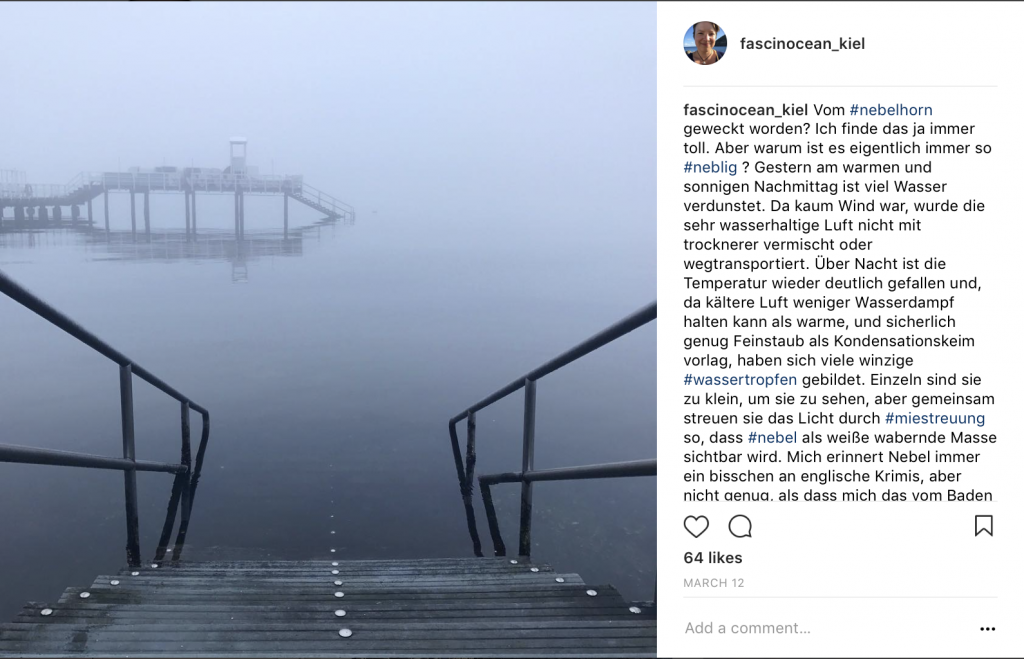
But as you see: I think Instagram works a lot more through good photos, and only second through good messages that come with the pictures. Also turns out that a lot of my “followers” don’t actually read German but rely on the translations that Instagram provides (which seem to be pretty good, all in all). But I wonder whether I would have been able to reach a german-speaking audience had I written in English (which I would actually prefer, since it feels more inclusive). I’ve seen people post in several languages, but I am definitely too lazy for that, especially when I am posting from my phone and not my computer.
Instagram also works way beyond Instagram for me. Some of my posts, I have also shared on my personal Facebook and I was really impressed with the impact those have had: Several people have approached me in person at my work to tell me how much they enjoy learning about oceanography through those posts. Most notably a professor who is known to be highly sceptical of using social media in science communication. Ha! But then also other colleagues who I don’t usually talk to. So it’s working!
What I didn’t expect: How addictive Instagram is, and not only Instagram, but especially the app that I use to edit and post. For the first phase of my Instagram career, I used an app called UNUM to plan my feed: I could upload pictures, edit them, write the captions, collect the hashtags, and lay the pictures out so I liked the overall look of my feed, and look at stats. But then half way through the month, the app started working for me (I can’t log in and it’s driving me NUTS! Please fix it!!! Update: it is fixed! I’m so happy! :-)). I’ve found a different app that kinda does the same one as the first, but I miss UNUM! I had so much more fun with it and the new one isn’t half as much fun, and neither is Instagram without UNUM. Hope it’ll be resolved soon! But I found it very interesting to see that an important part of my “Instagram experience” is actually a third party app.
What’s next? I will continue posting as fascinocean_kiel. It is fun! But I won’t attempt to post daily in the long run, turns out that that requires a much bigger commitment than I am willing to keep up. It’s not like this is my only hobby, or my only scicomm activity… And I am also toying with the idea of expanding the kind of posts I am doing, to occasionally include some #scientistswhoselfie pictures and stories. What do you think? What would you like to see?
Oh, and I need to figure out why posting gifs isn’t working for me. Absolutely no idea what’s going wrong!
b) And here is my instagram feed
All the pictures and (german) captions that I posted on Instagram for your viewing pleasure. Give me a shout if you need a translation for anything and I am happy to provide one, am just too lazy to translate everything if nobody reads it anyway… And, btw, you know you can actually see my Instagram feed even if you aren’t using the app, right? ;-)
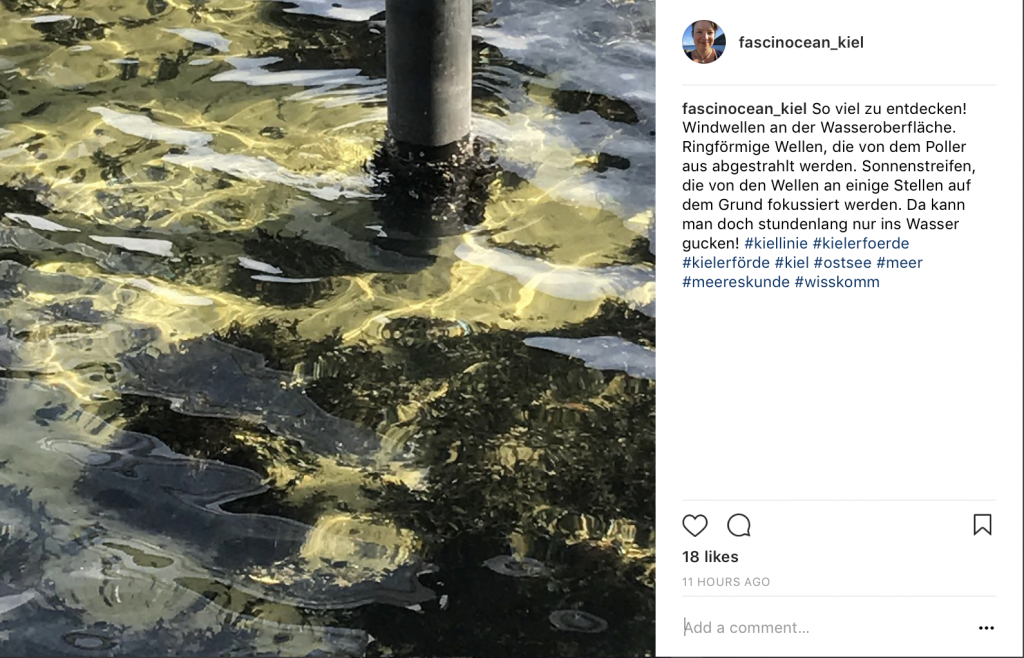
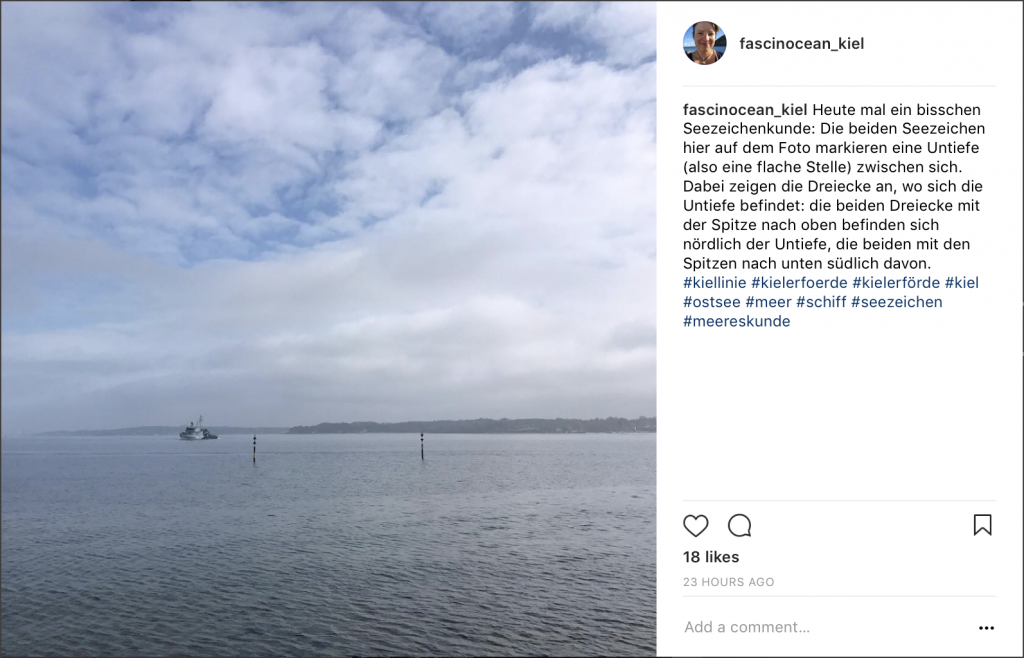
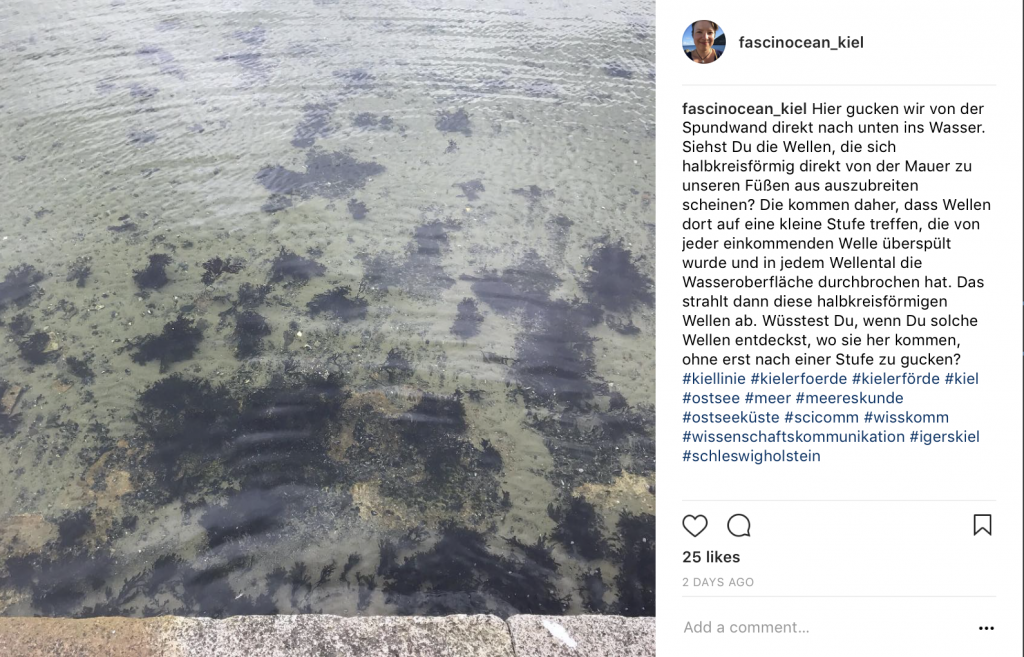


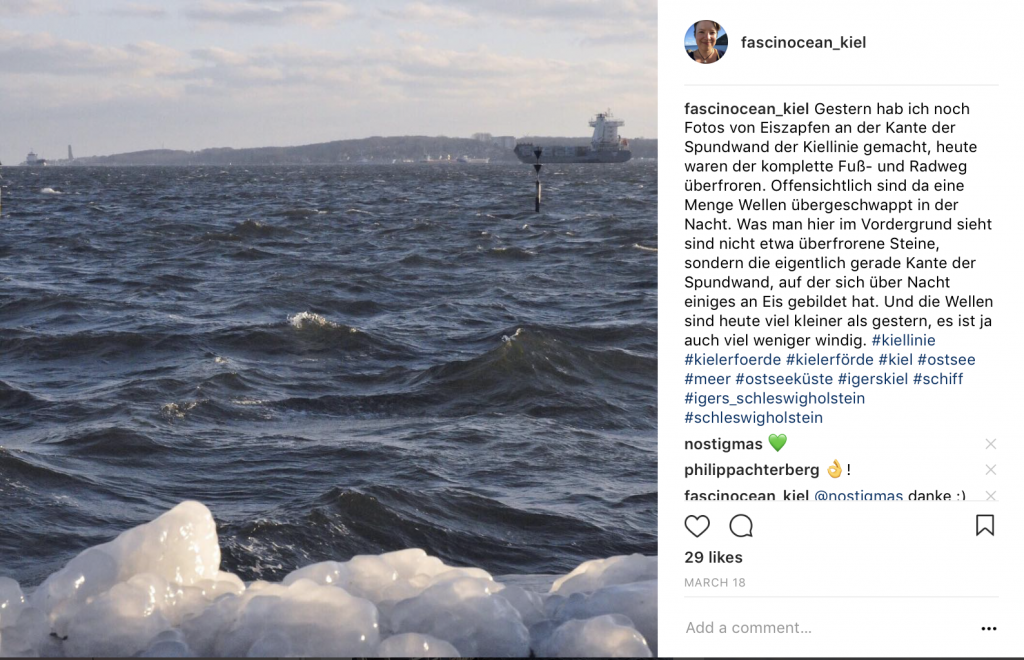
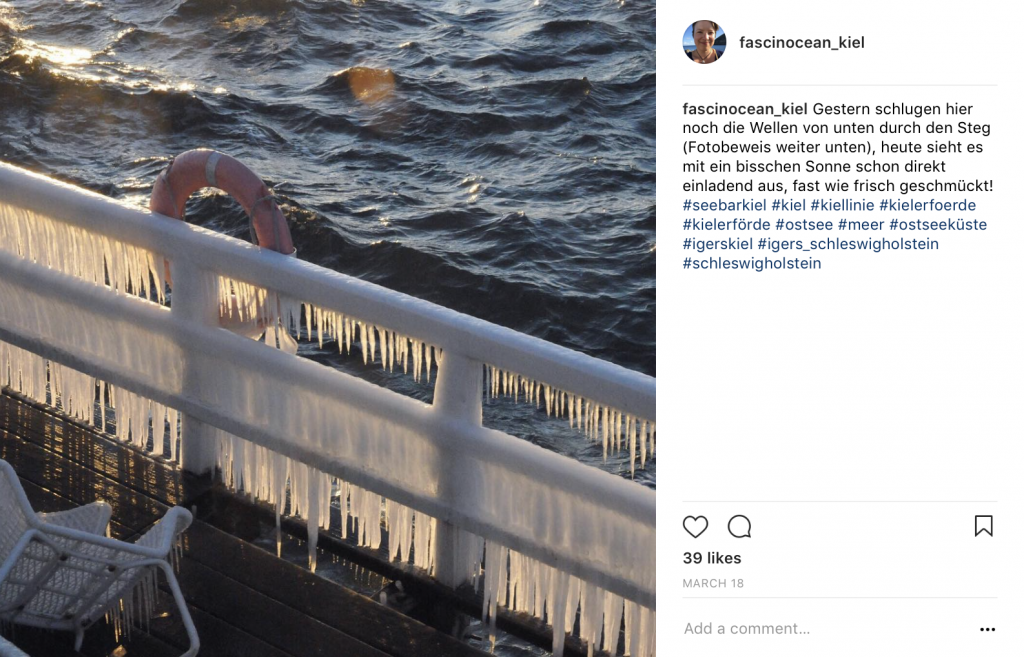
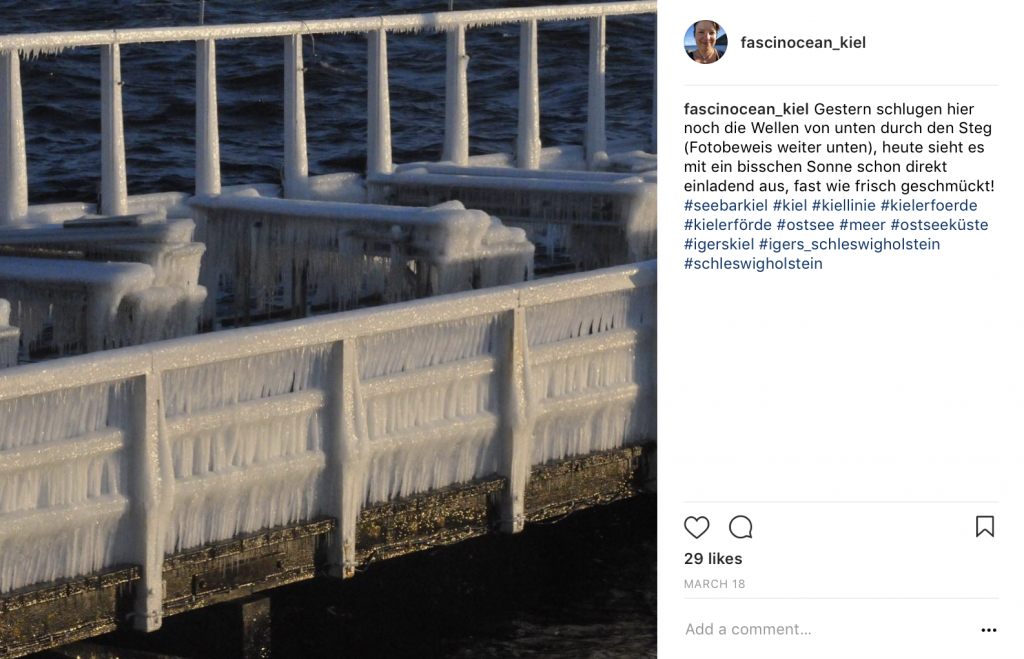
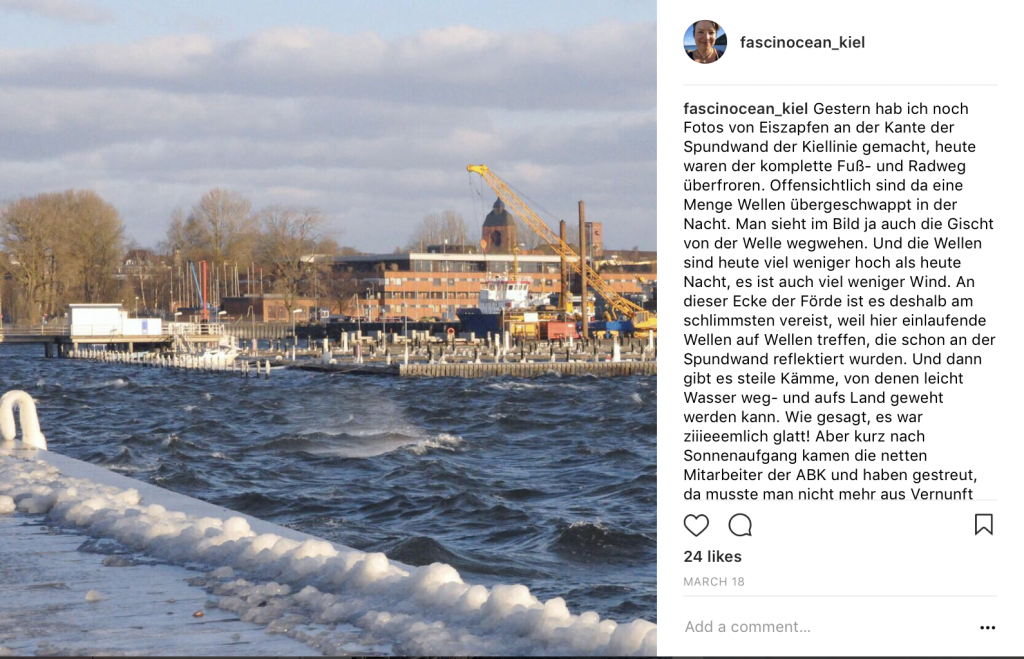
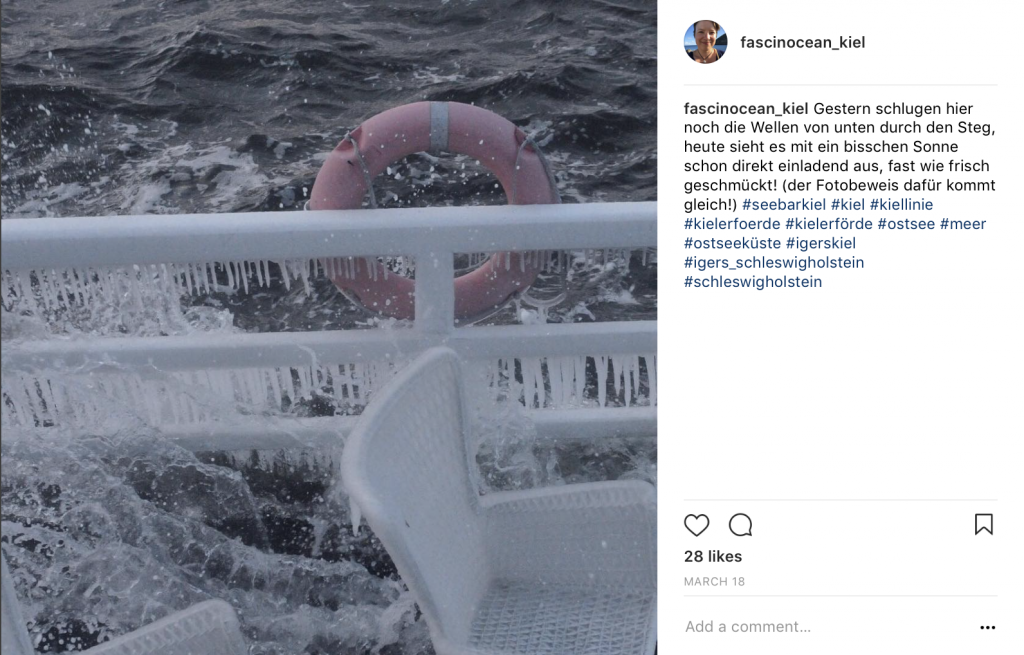
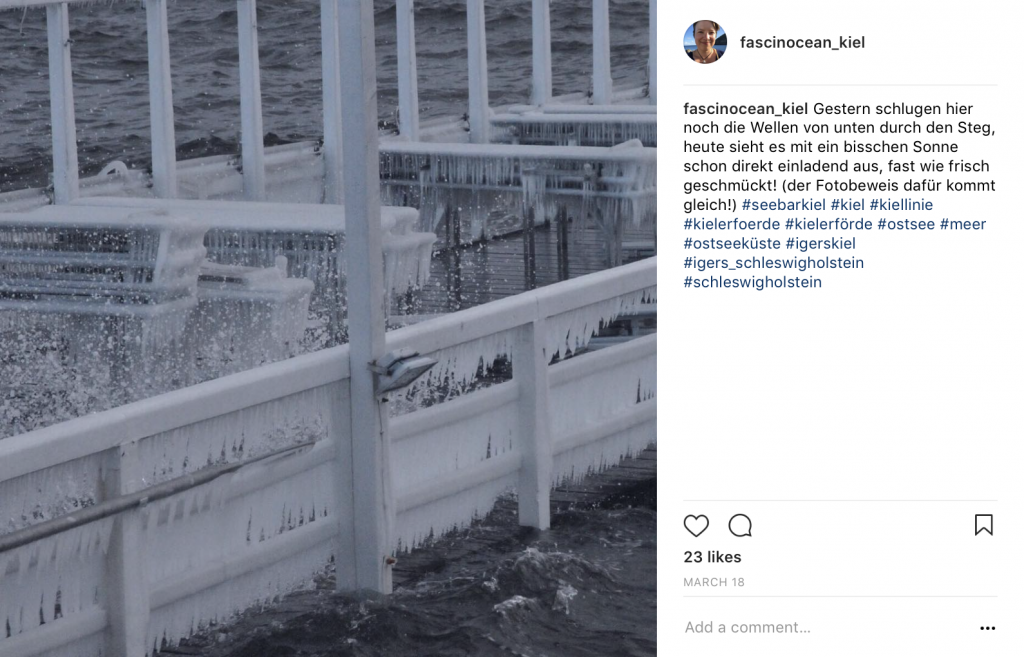
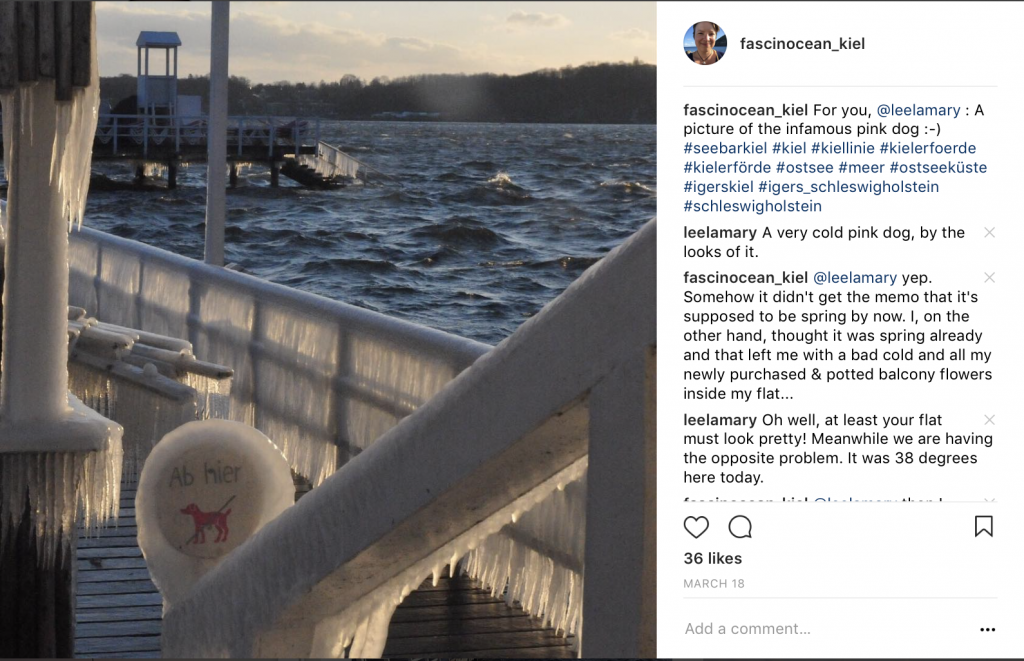
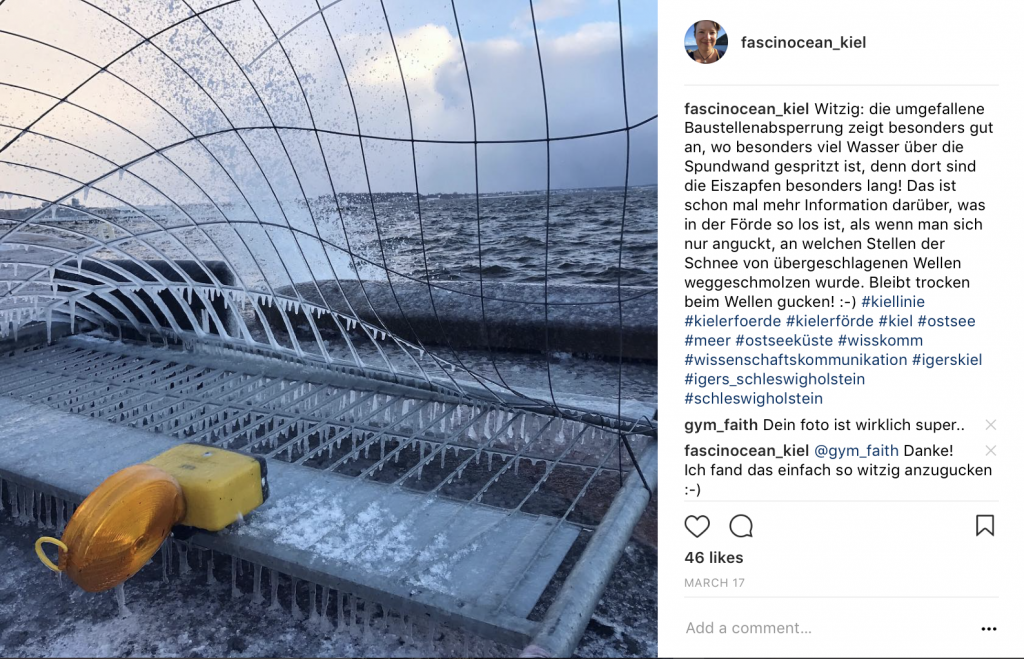
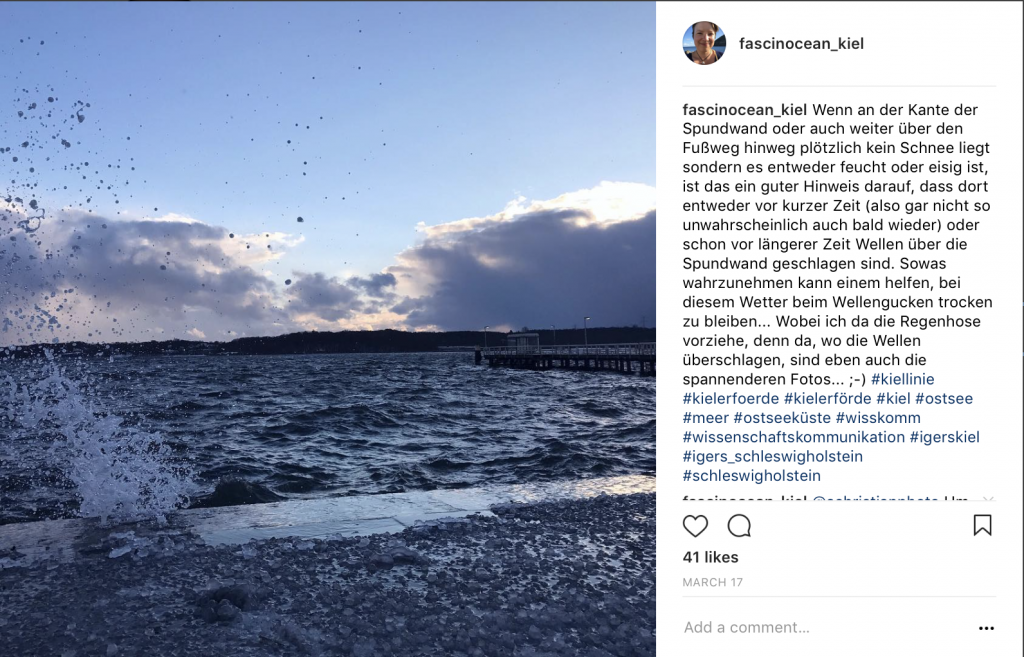
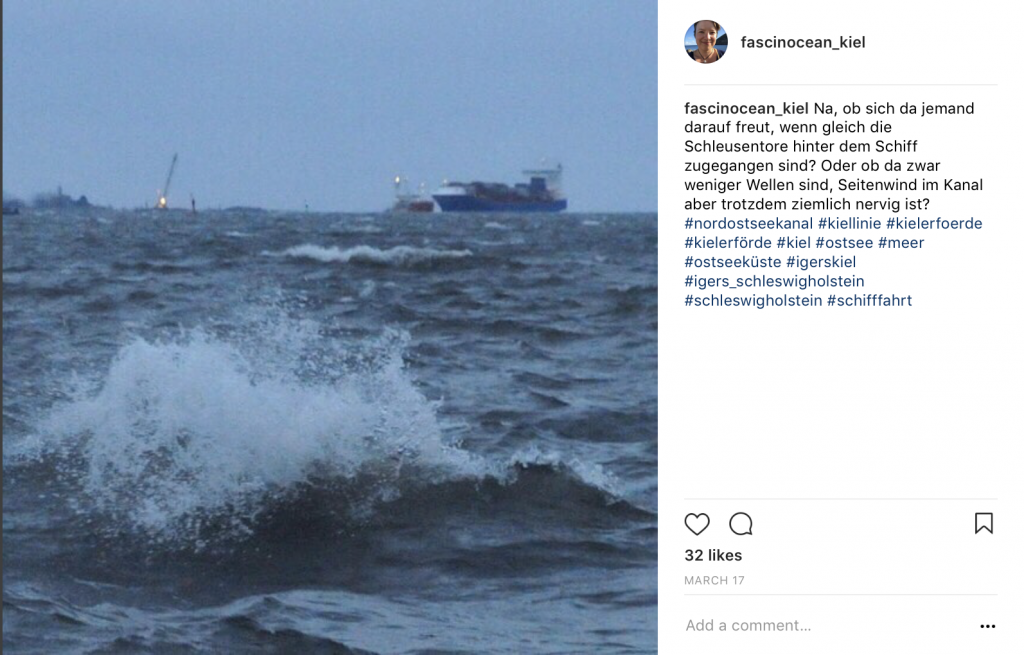
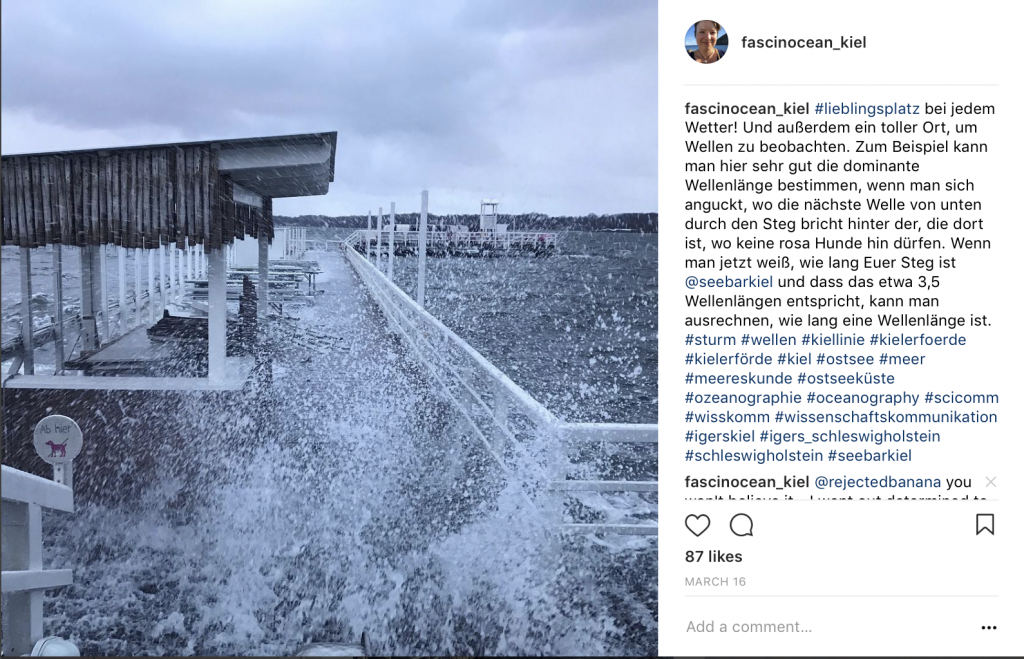
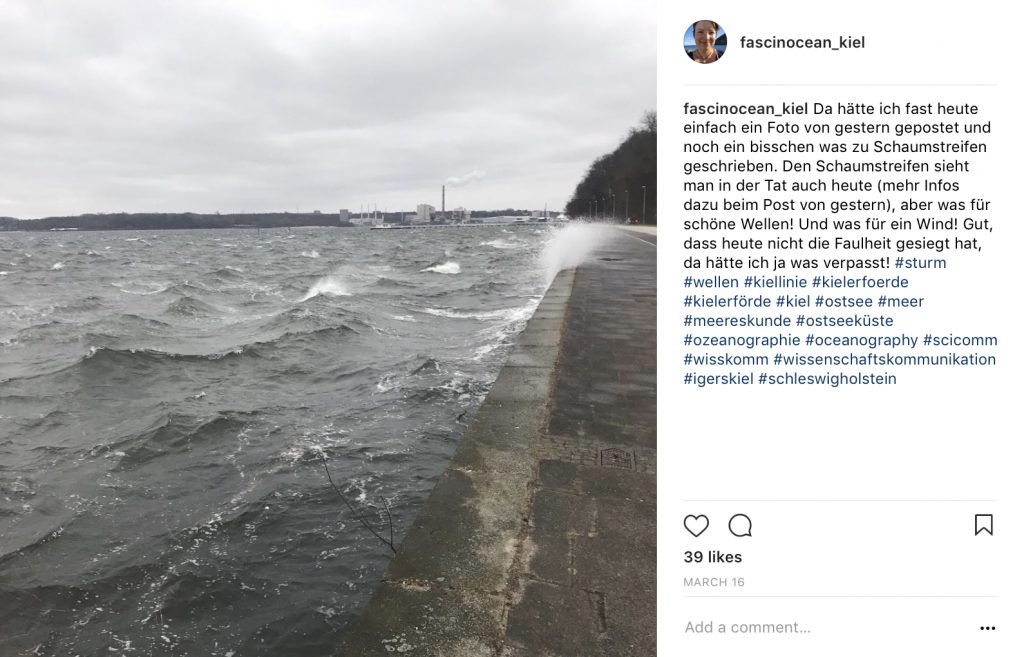


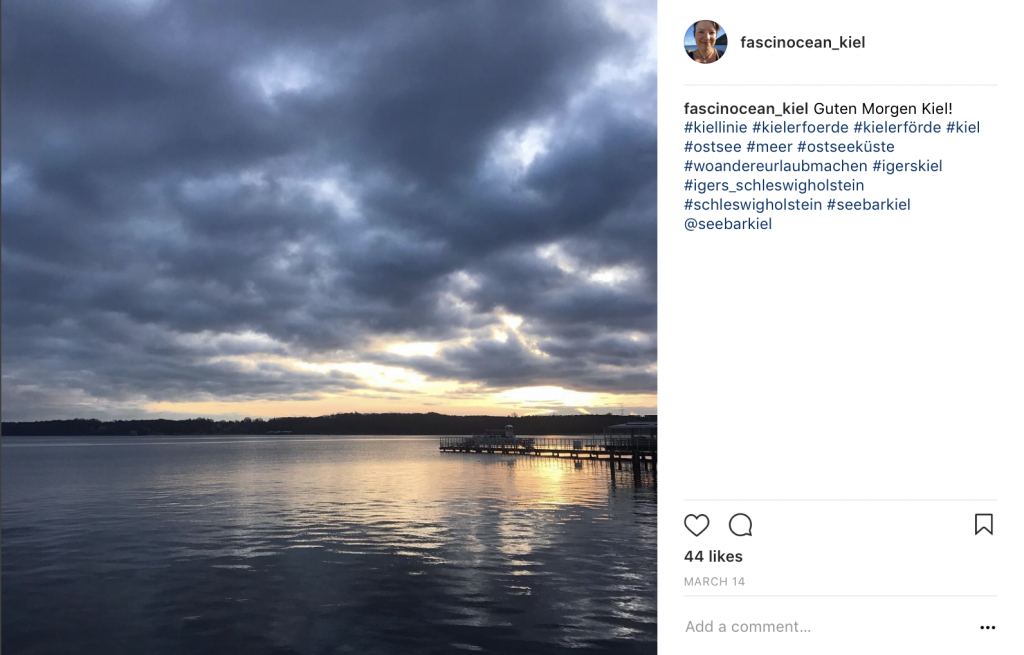
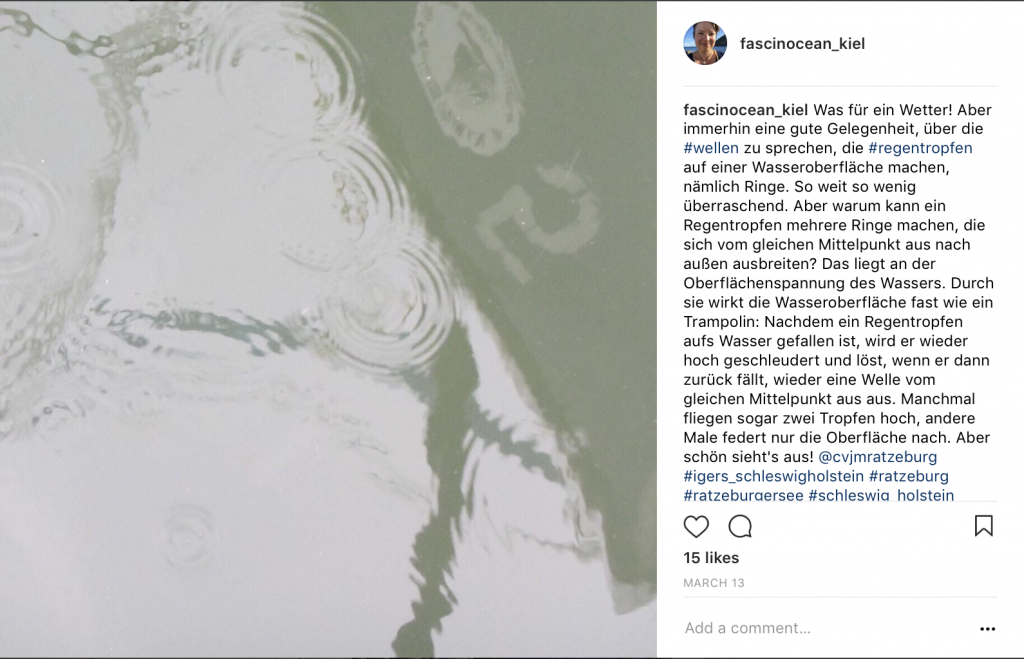

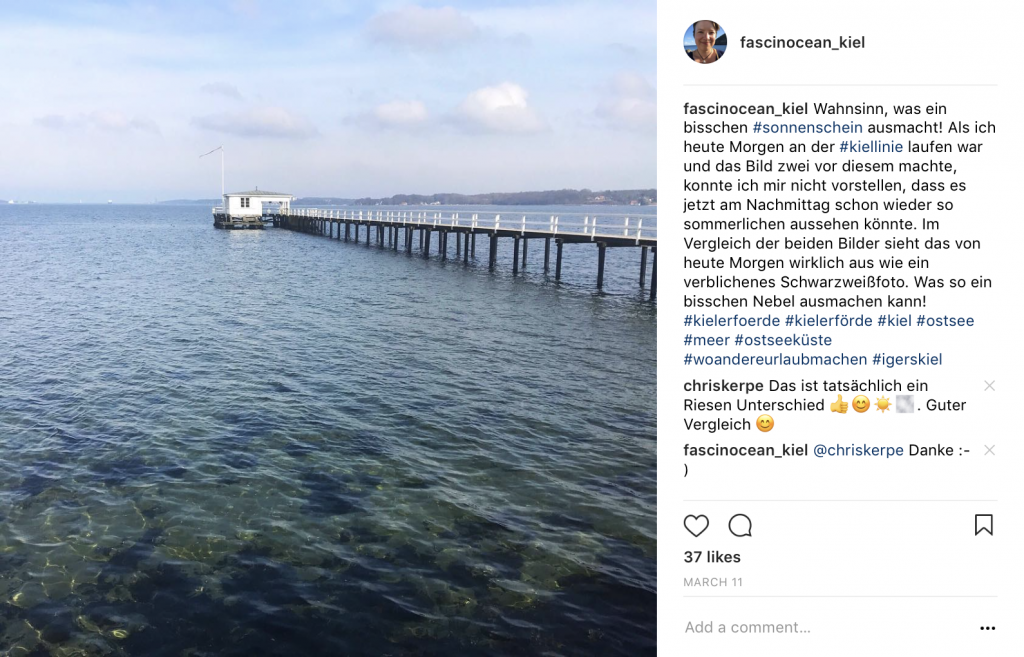
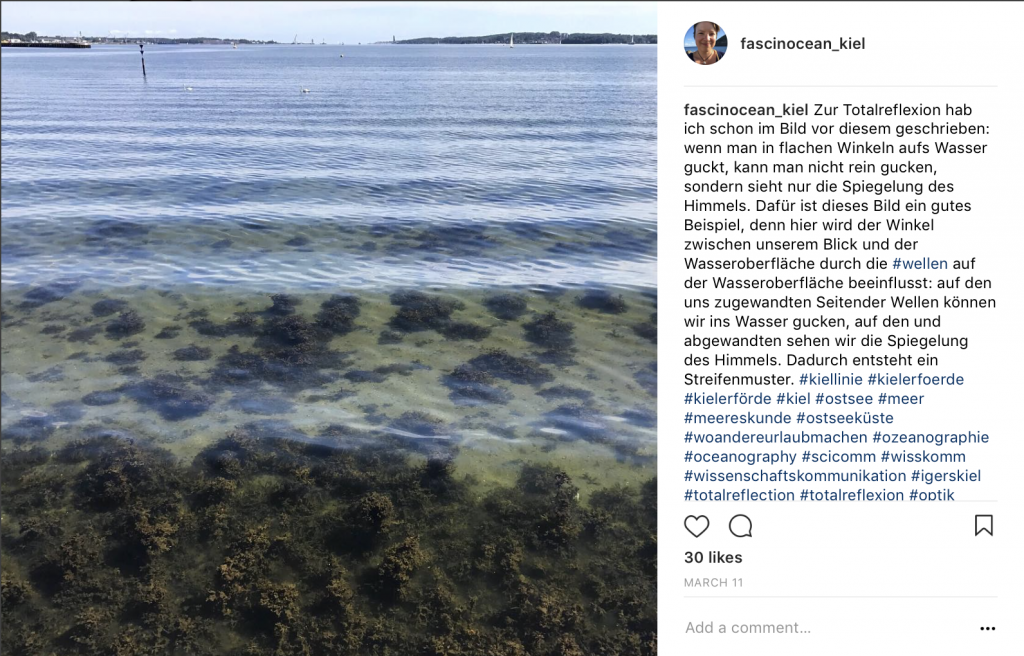
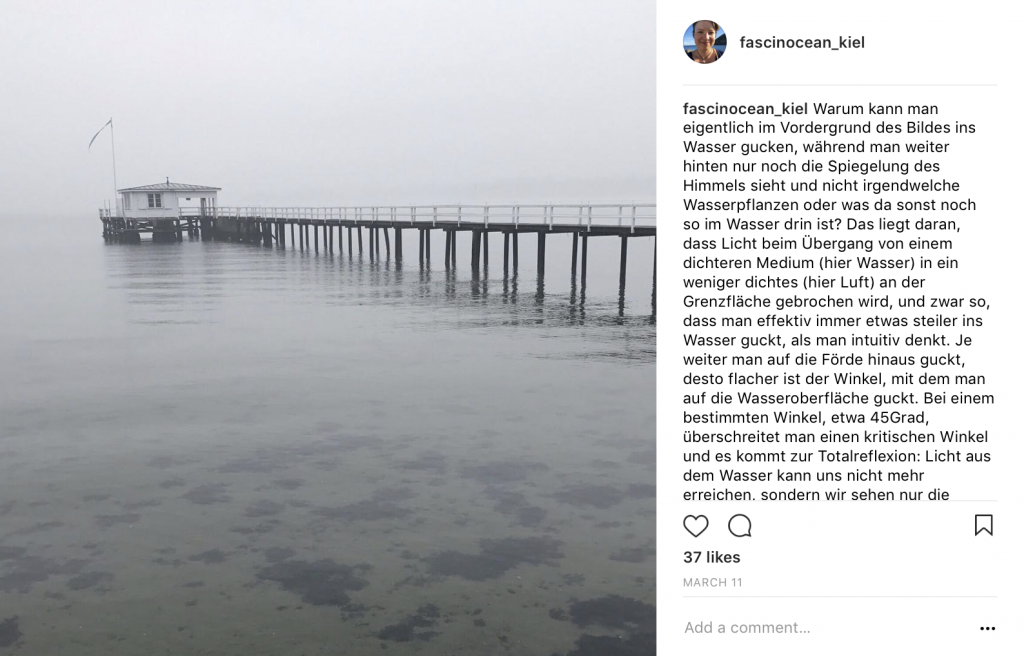
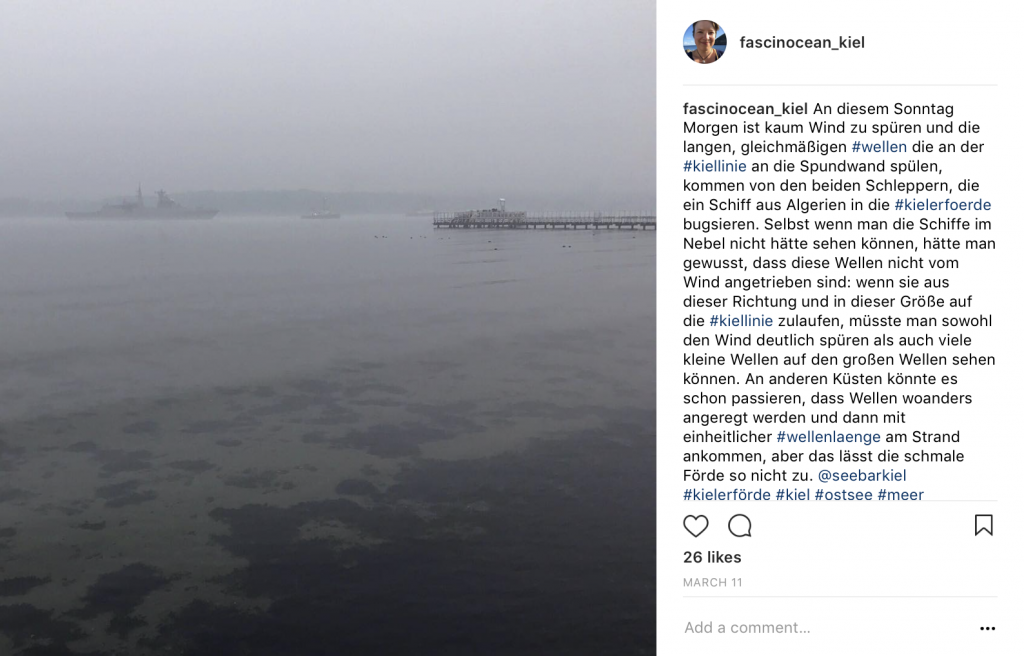
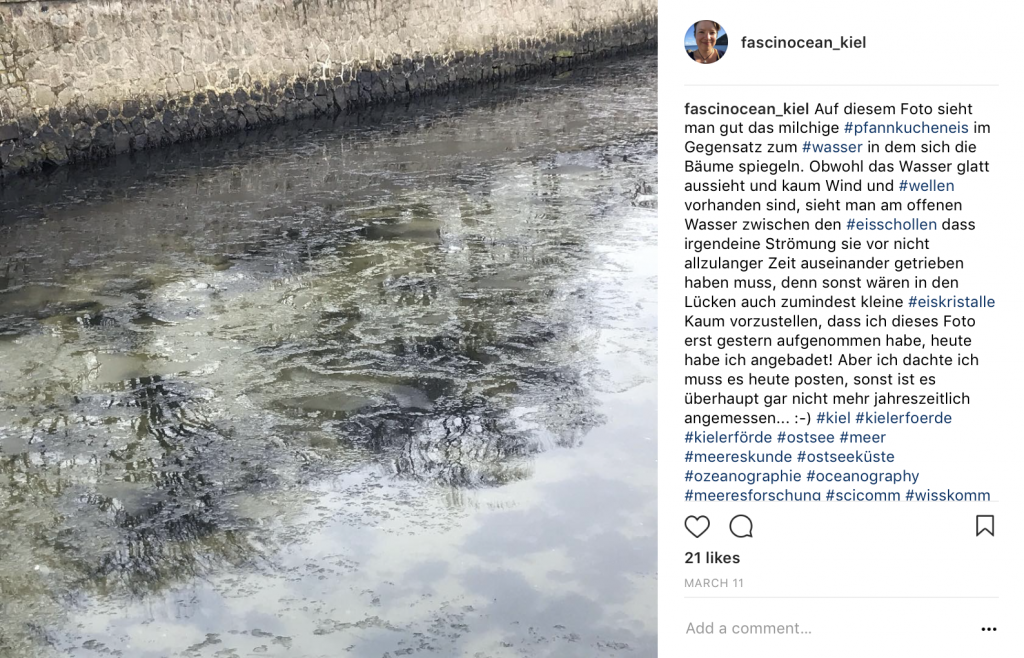
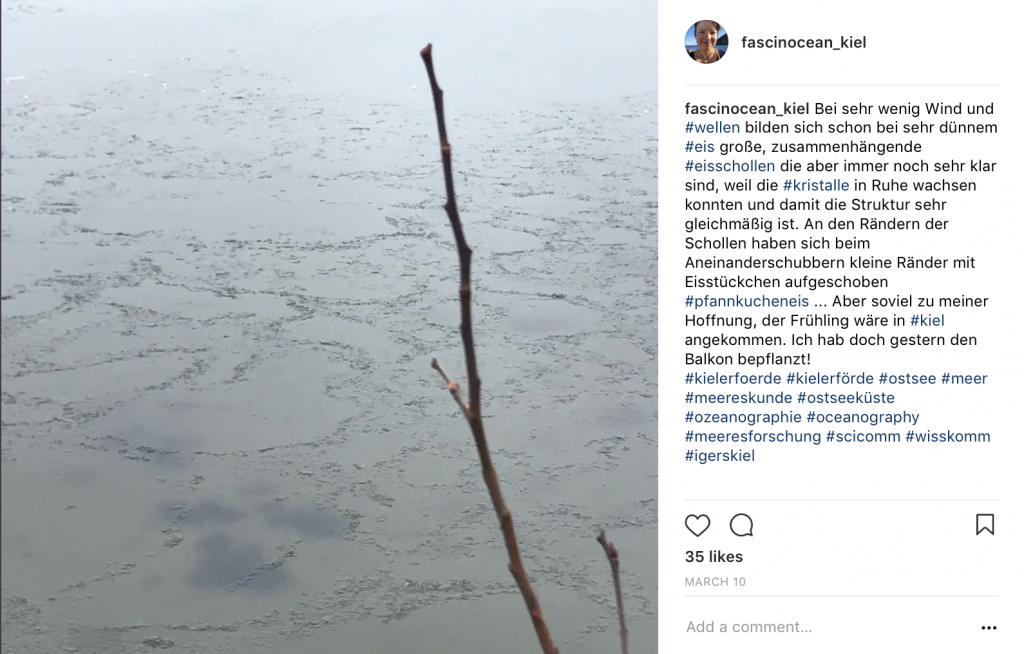

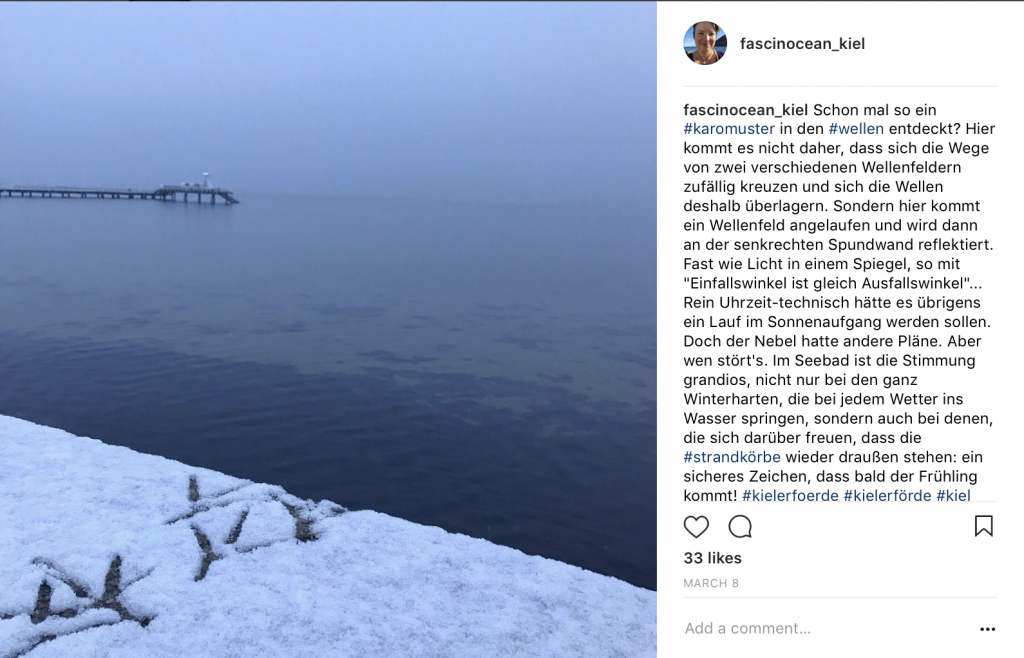

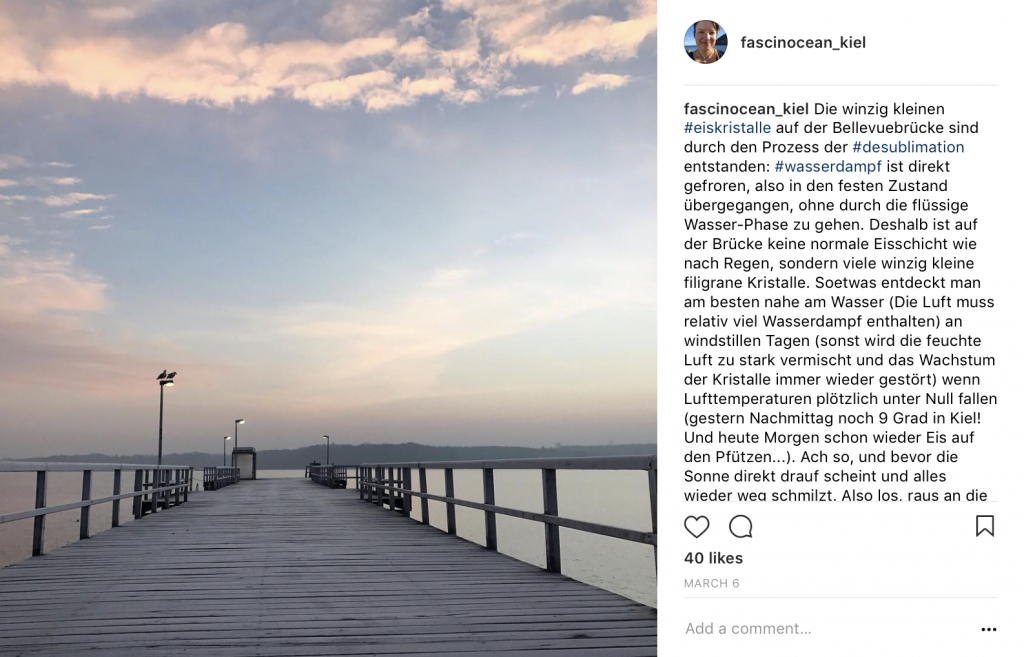

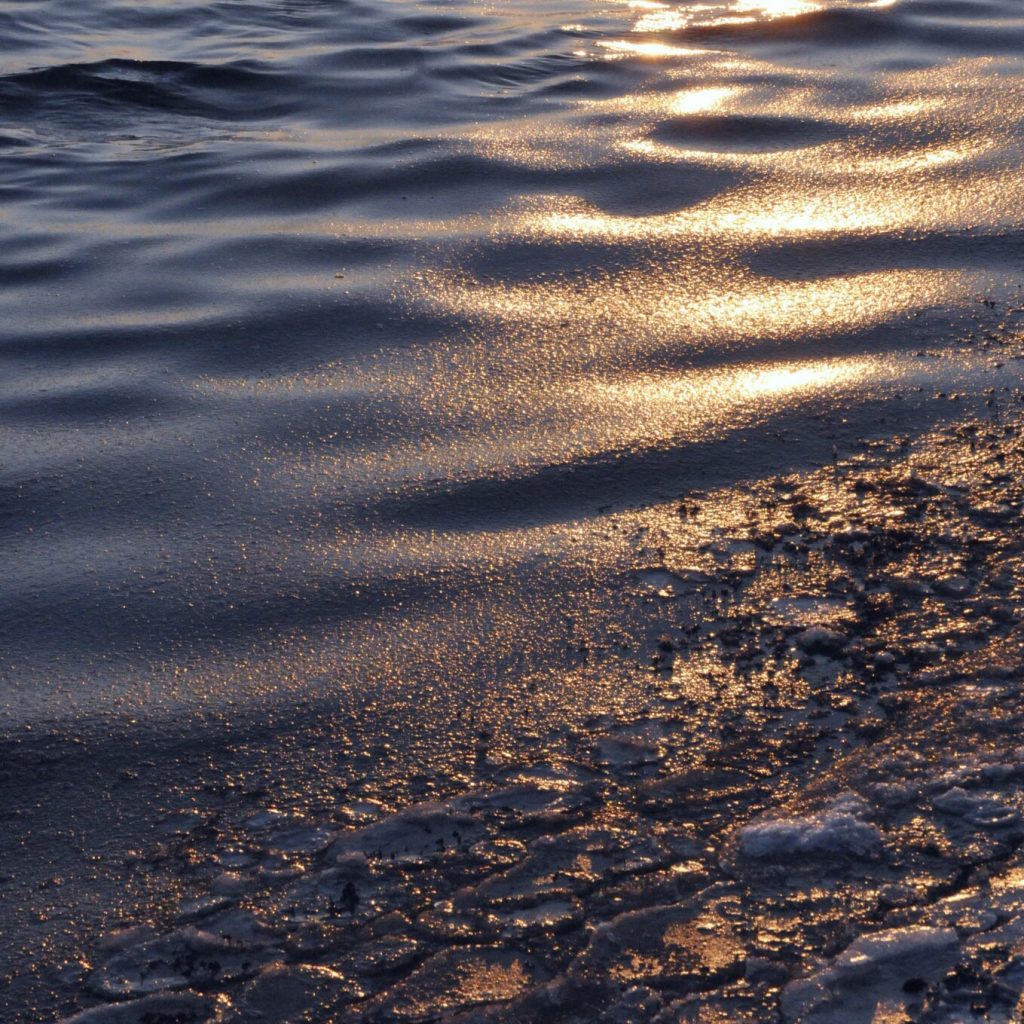
Die unterschiedlichen Stadien der Eisbildung in einem Foto: Vom offenen Wasser im Hintergrund, über das ölig aussehende Wasser, in dem schon viele kleine Eiskristalle schwimmen, hin zu #pfannkucheneis da, wo schon #eiskristalle zu #eisschollen zusammen gefroren sind. Die etwas erhöhen Ränder kommen daher, dass die Pfannkuchen aneinander schubbern und Eis auf die Ränder aufschieben.
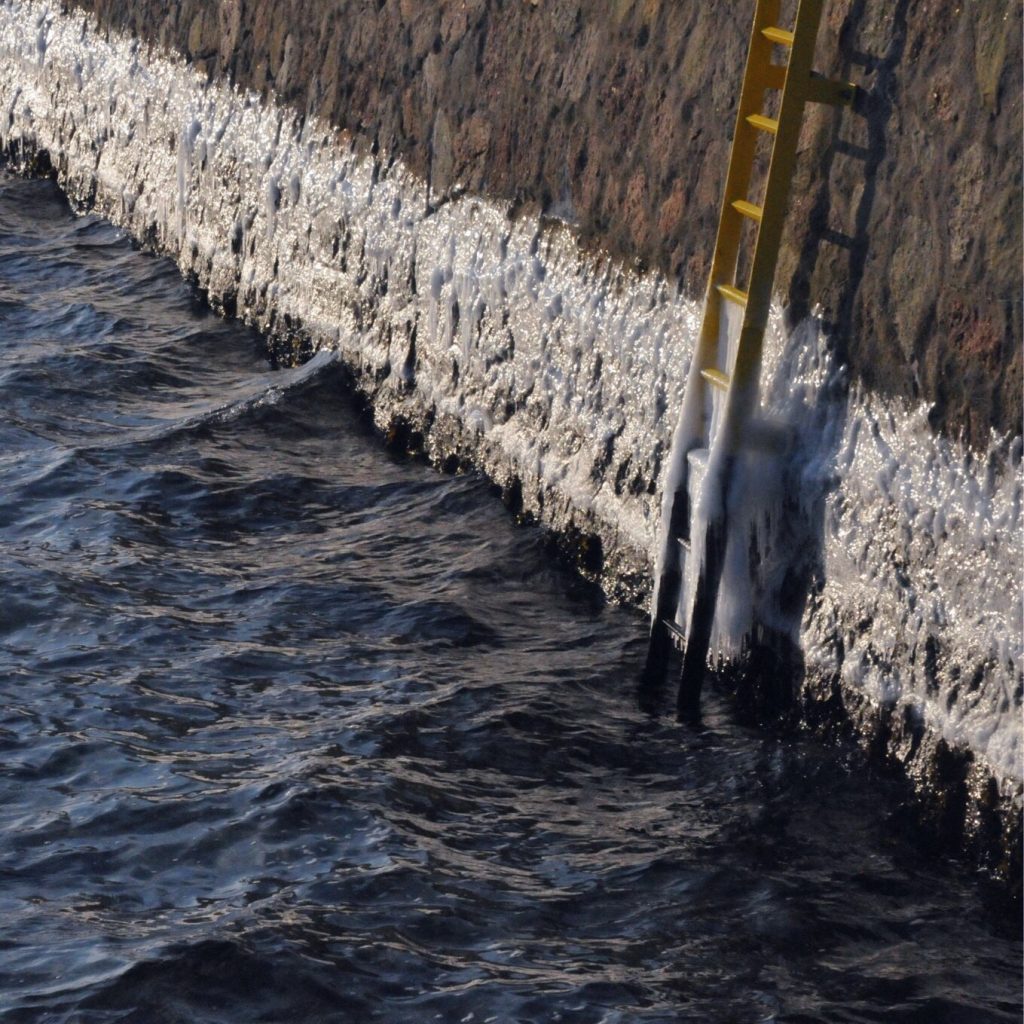
Wie schön einem das #eis an der #spundwand anzeigt, wie hoch in den letzten Tagen das Wasser gespritzt hat!
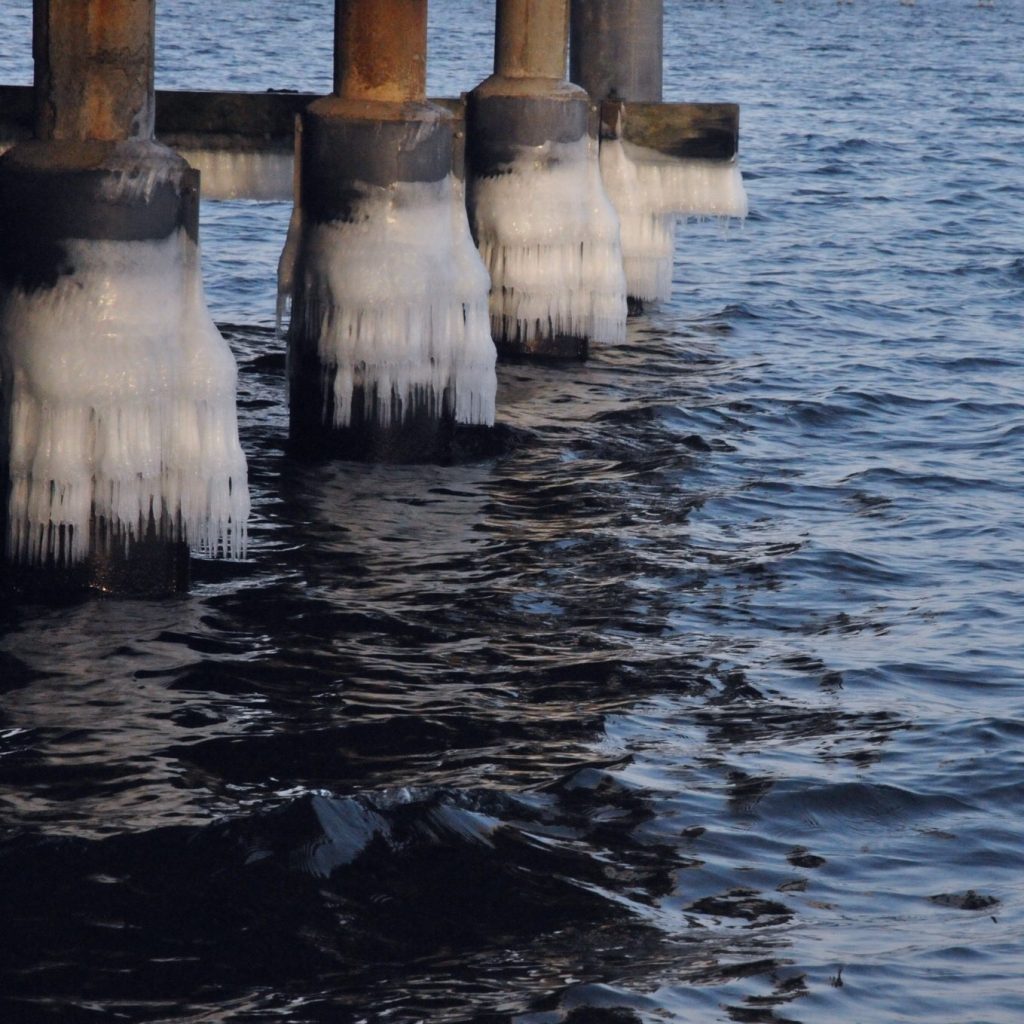
#eiszapfen zeigen die Wasserstände der letzten Tage an: zuerst war Wasser etwa bis zur unteren Kante der obersten Eiszapfenlage. Manchmal ist es höher gespritzt und dann an den Eiszapfen gefroren, aber weiter als bis zur Wasseroberfläche konnten sie nicht nach unten wachsen. Dann ist der Wasserstand gesunken bis zur nächsten Grenze. Und jetzt ist noch weniger da. Sieht es nicht wunderschön aus?
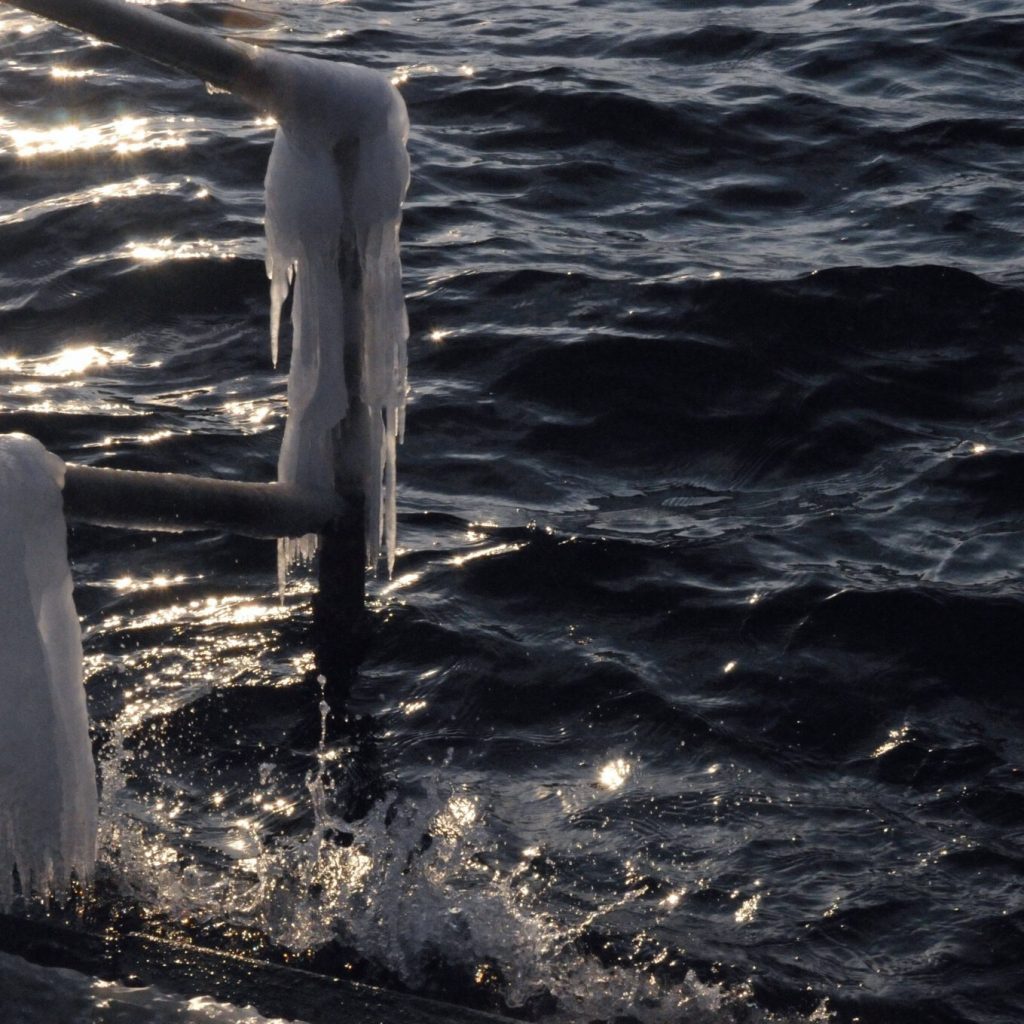
Wie war das mit #anbaden2018 @seebarkiel ? Aber wunderschön ist es trotzdem!
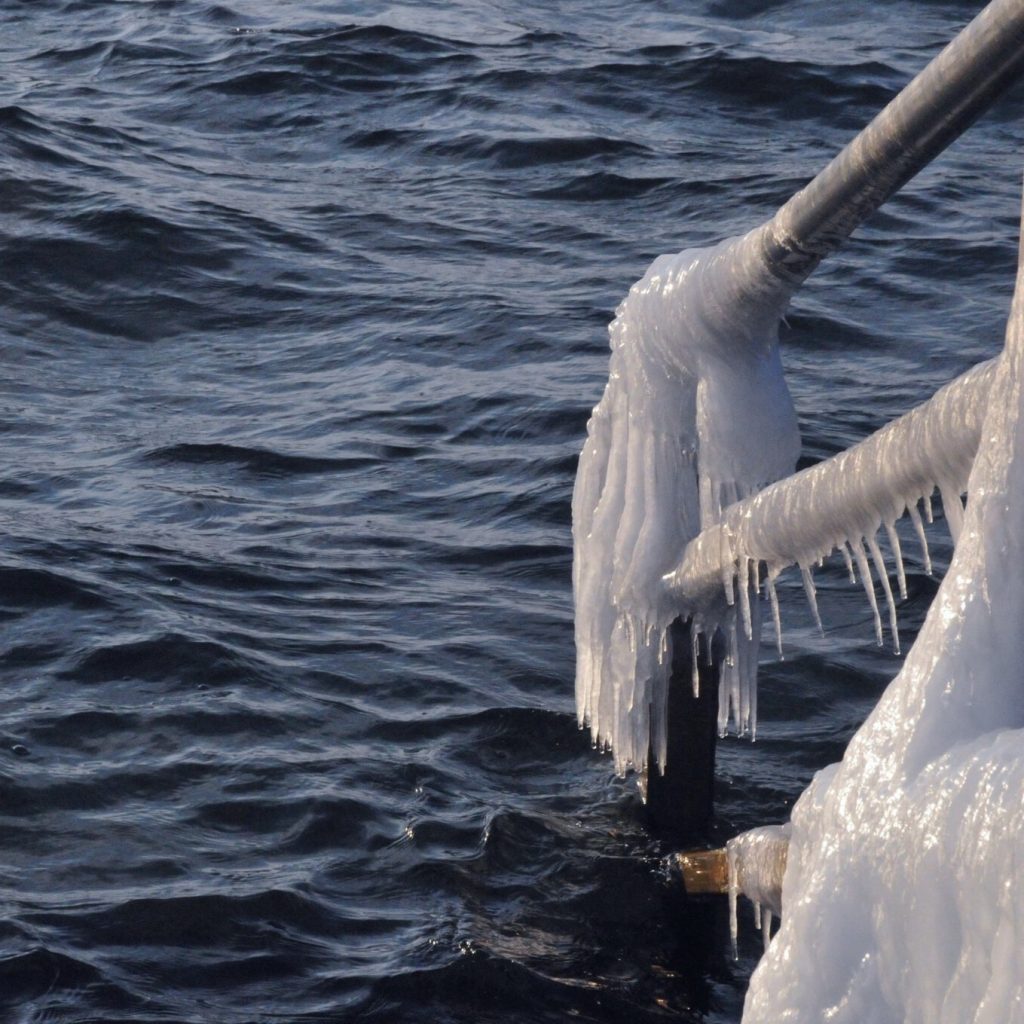
Was ich hier total spannend finde: einige #eiszapfen hängen senkrecht nach unten (wie man sich das so vorsstellt). Andere sehen aus, als würden sie vom Wind nach rechts geweht. Meine Vermutung ist, dass sie zu unterschiedlichen Zeiten entstanden sind: die geraden bei weniger Wind als die krummen. Denn dass Tropfen, die gegen Eiszapfen geweht werden, auf die windabgewandte Seite getrieben werden und dort gefrieren (und dass so der ganze Eiszapfen schief wird) macht ja auch irgendwie Sinn.
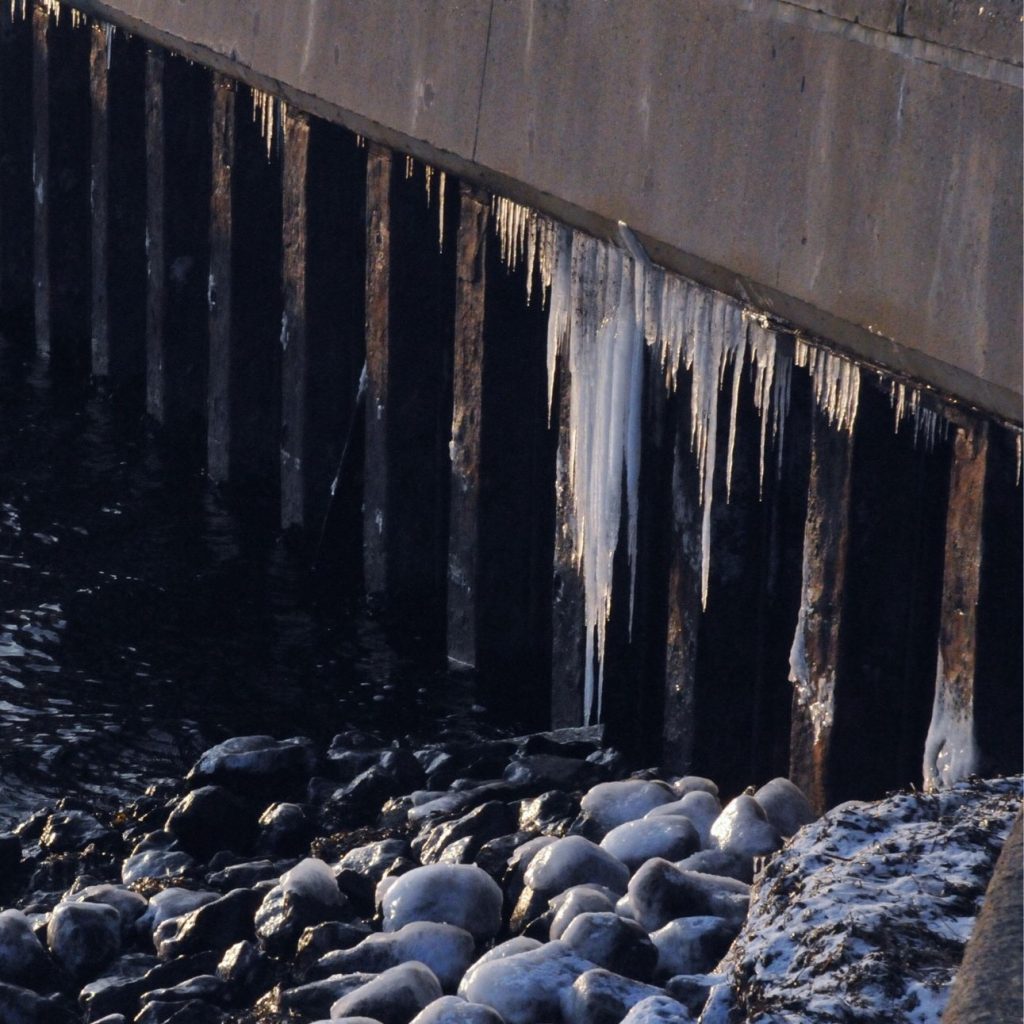
Verschiedenste Formen von flüssigem und gefrorenem Wasser. Ganz oben auf den Steinen liegt Schnee. Etwas weiter unten sind sie mit Fördewasser überfroren und sehen aus wie mit Zuckerguss glasiert. Und im Hintergrund dann Eiszapfen… Nicht zu vergessen: die noch nicht gefrorene Förde!
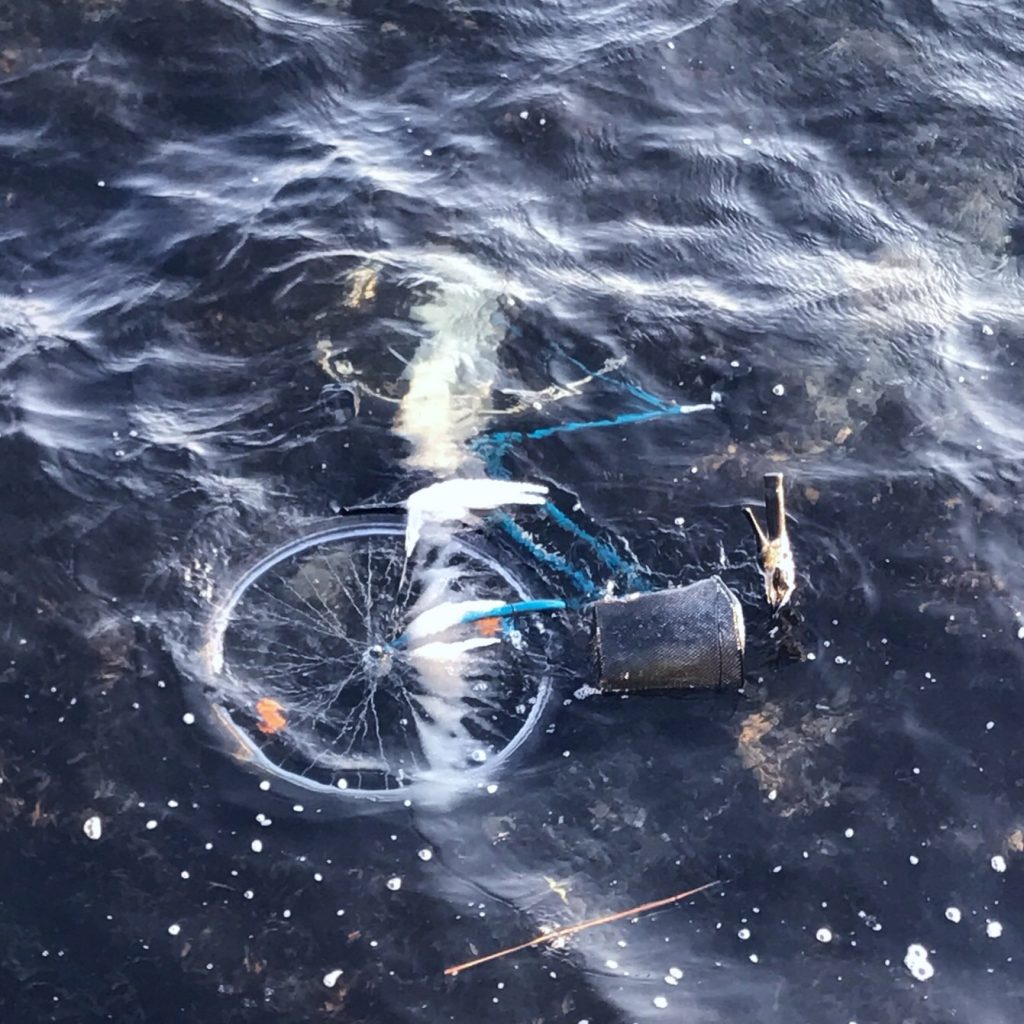
Lustig: die #eiszapfen am Fahrrad zeigen, dass es noch nicht lange so im Wasser gelegen haben kann…
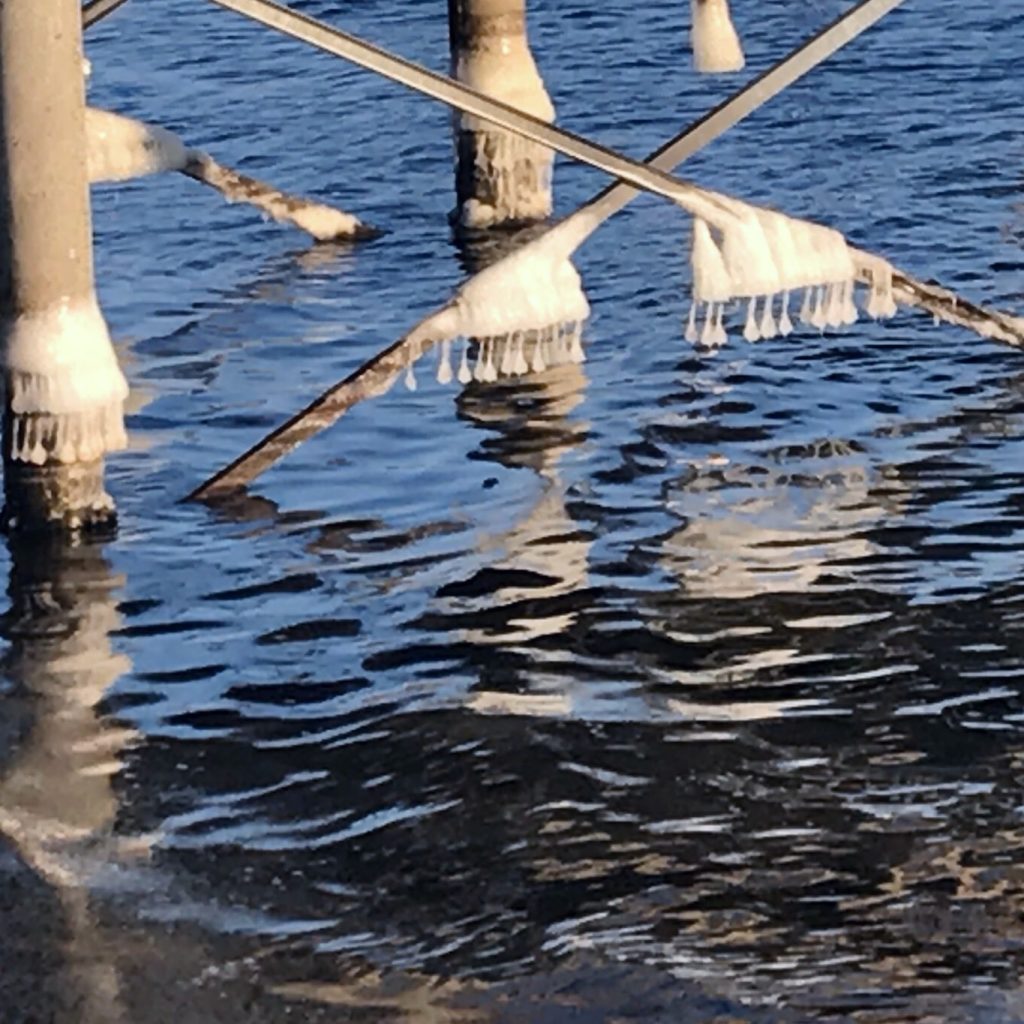
#eiszapfen zeigen die Wasserstände der letzten Tage an: zuerst war Wasser etwa bis zur unteren Kante der obersten Eiszapfenlage. Manchmal ist es höher gespritzt und dann an den Eiszapfen gefroren, aber weiter als bis zur Wasseroberfläche konnten sie nicht nach unten wachsen. Dann ist der Wasserstand gesunken bis zur nächsten Grenze. Und jetzt ist noch weniger da. Sieht es nicht wunderschön aus?

#eiszapfen zeigen die Wasserstände der letzten Tage an: zuerst war Wasser etwa bis zur unteren Kante der obersten Eiszapfenlage. Manchmal ist es höher gespritzt und dann an den Eiszapfen gefroren, aber weiter als bis zur Wasseroberfläche konnten sie nicht nach unten wachsen. Dann ist der Wasserstand gesunken bis zur nächsten Grenze. Und jetzt ist noch weniger da. Sieht es nicht wunderschön aus?
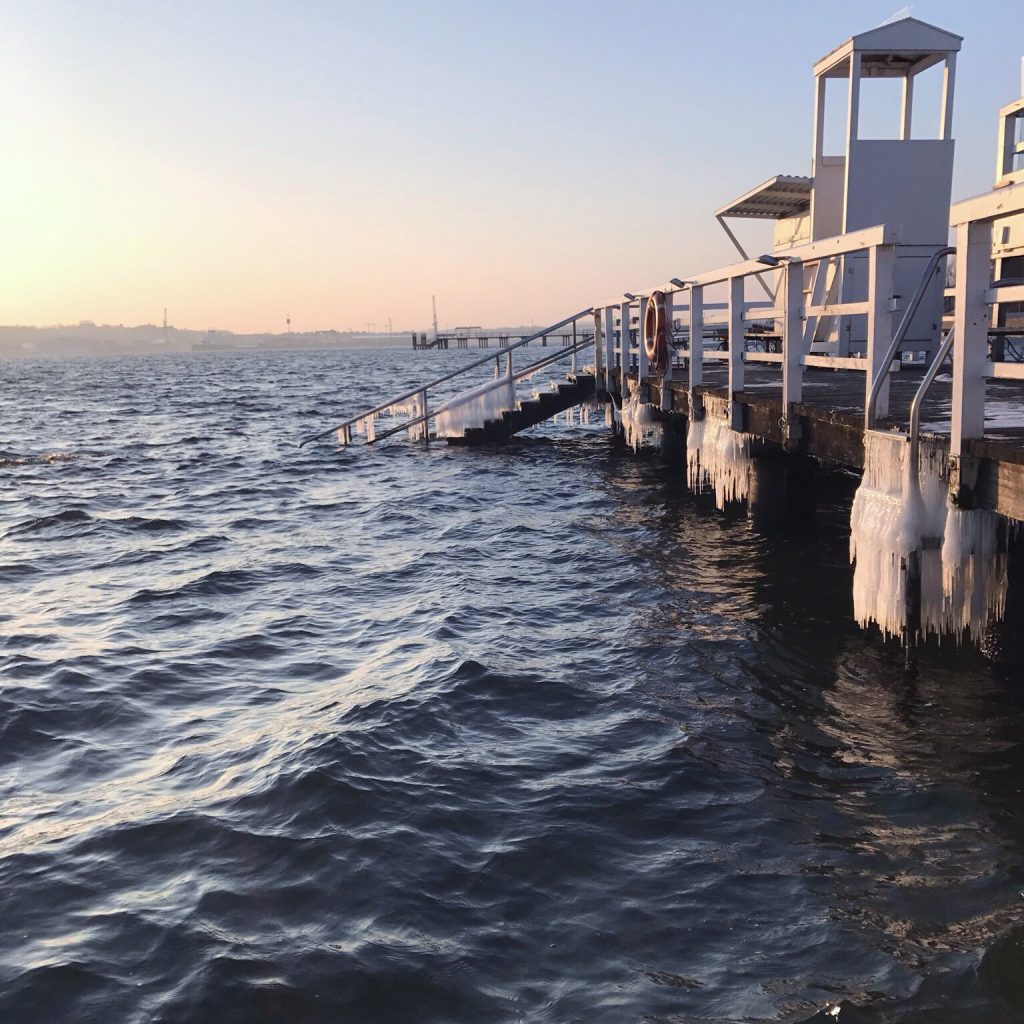
Wunderschöne Eiszapfen und Sonnenaufgang, wer freut sich da nicht auf den Sommer?
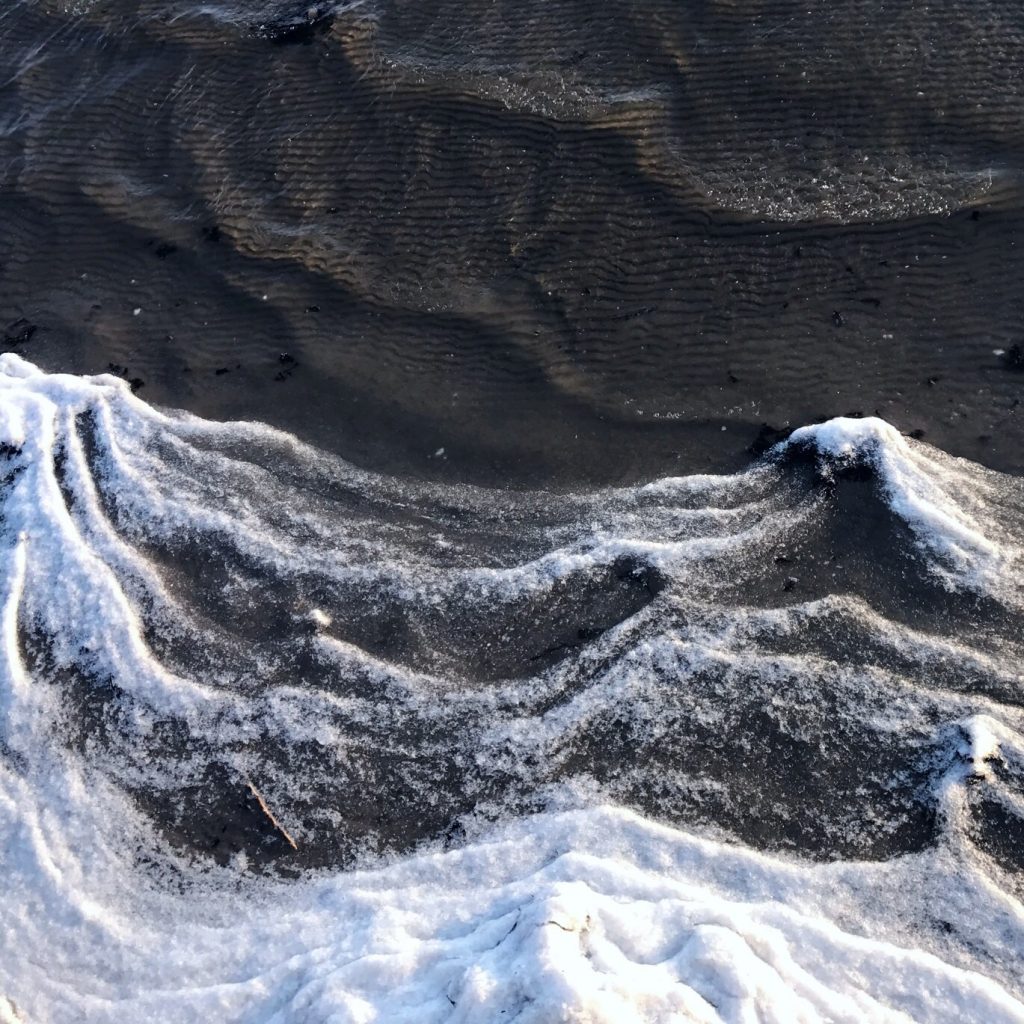
Diese Schneeverwehungen an der Kiellinie sehen irgendwie beeindruckend aus
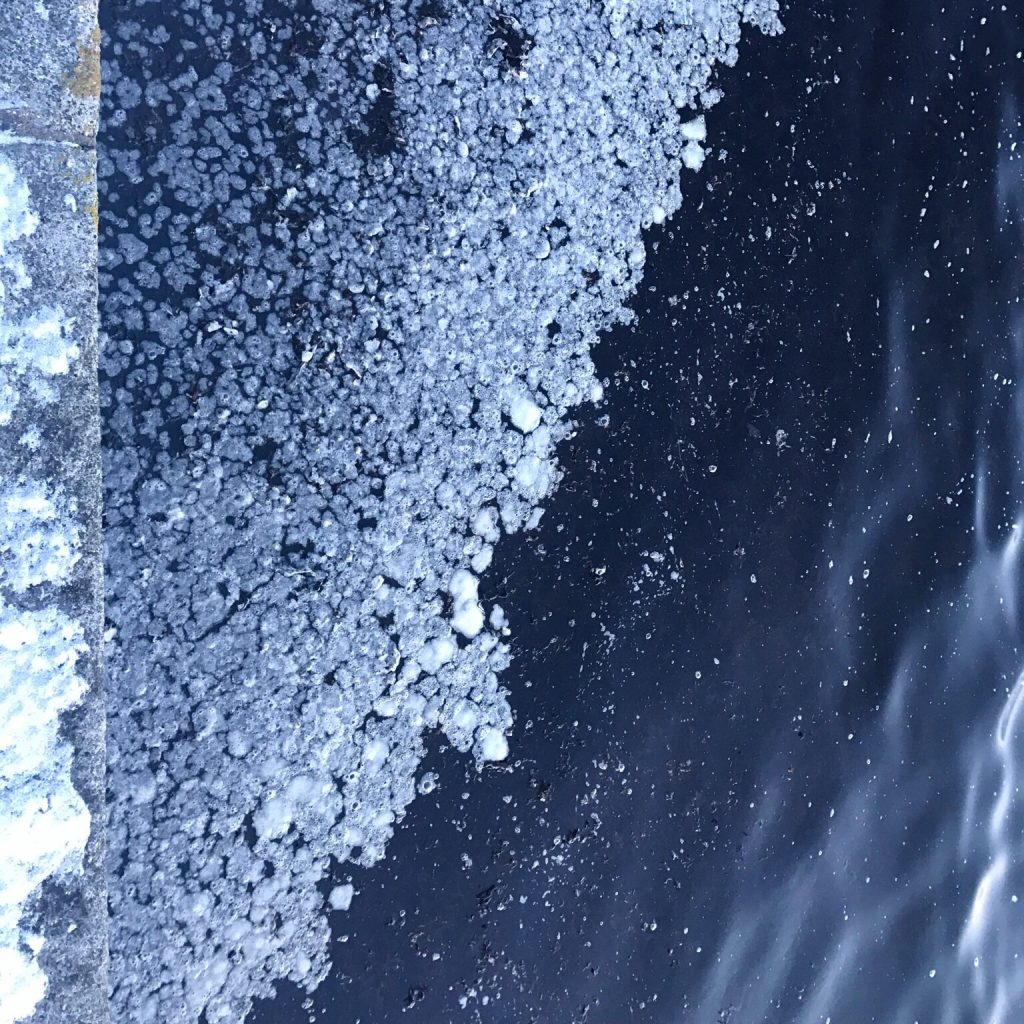
#pfannkucheneis auf der Kieler Förde! Nur an den Stellen, an denen sowohl die Wellen durch Pflanzen im Wasser ein wenig gedämpft werden als auch Schaum auf dem Wasser durch seine große Oberfläche schneller gefriert als der große Wasserkörper, aber nicht schlecht für den Anfang!

Neulich ging ich in der #forstbaumschule spazieren und siehe da: ein komplett grüner Teich! Sowas lässt mir dann ja keine Ruhe, bis ich herausgefunden habe, was da wohl passiert sein könnte. Stellt sich heraus, dass die @stadtwerke.kiel mit dem Farbstoff #uranin nach einem Leck in ihren Fernwärmeleitungen gesucht haben… Und noch Tage später war es grün!

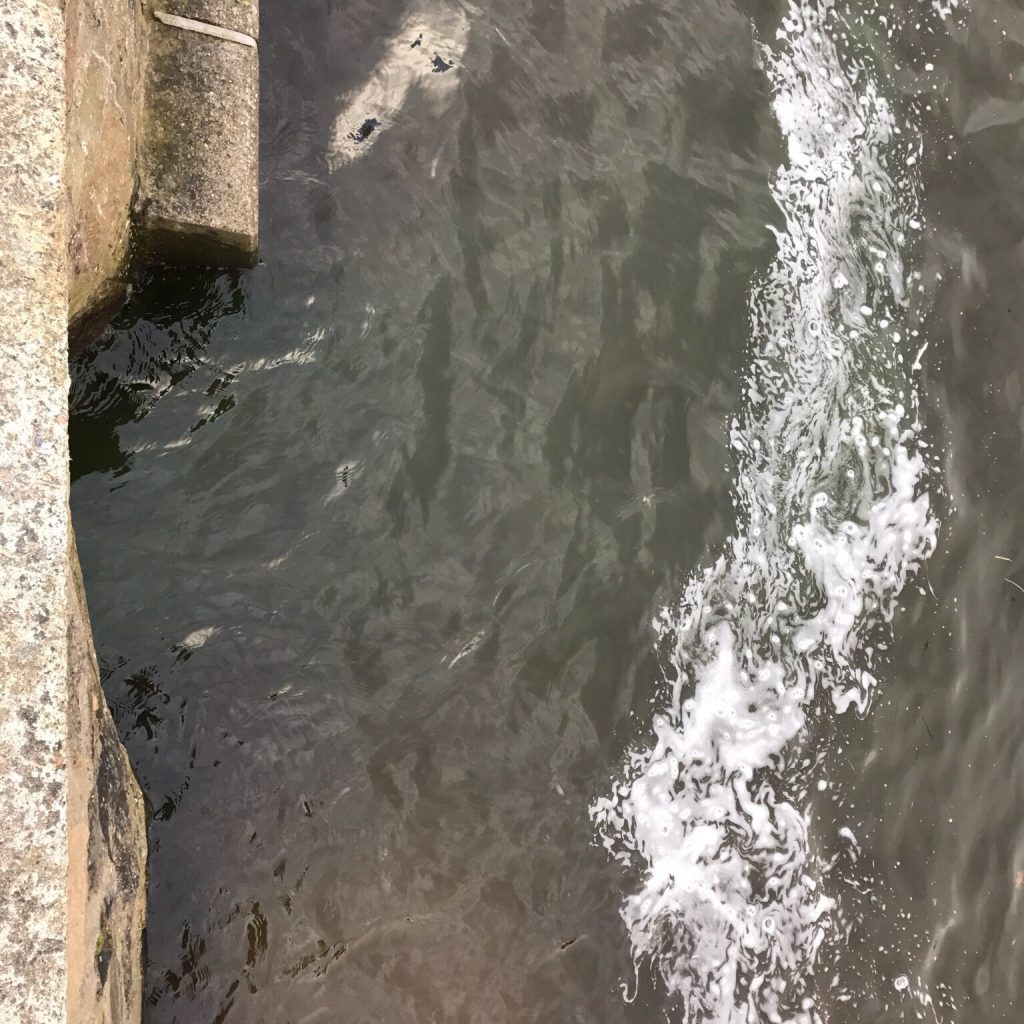
Neulich ging ich in der #forstbaumschule spazieren und siehe da: ein komplett grüner Teich! Sowas lässt mir dann ja keine Ruhe, bis ich herausgefunden habe, was da wohl passiert sein könnte. Stellt sich heraus, dass die @stadtwerke.kiel mit dem Farbstoff #uranin nach einem Leck in ihren Fernwärmeleitungen gesucht haben… Das Leck haben sie selbst gefunden und (vermutlich) gestopft, aber ich habe rausgefunden, wo der kleine Tümpel in die Förde abläuft…
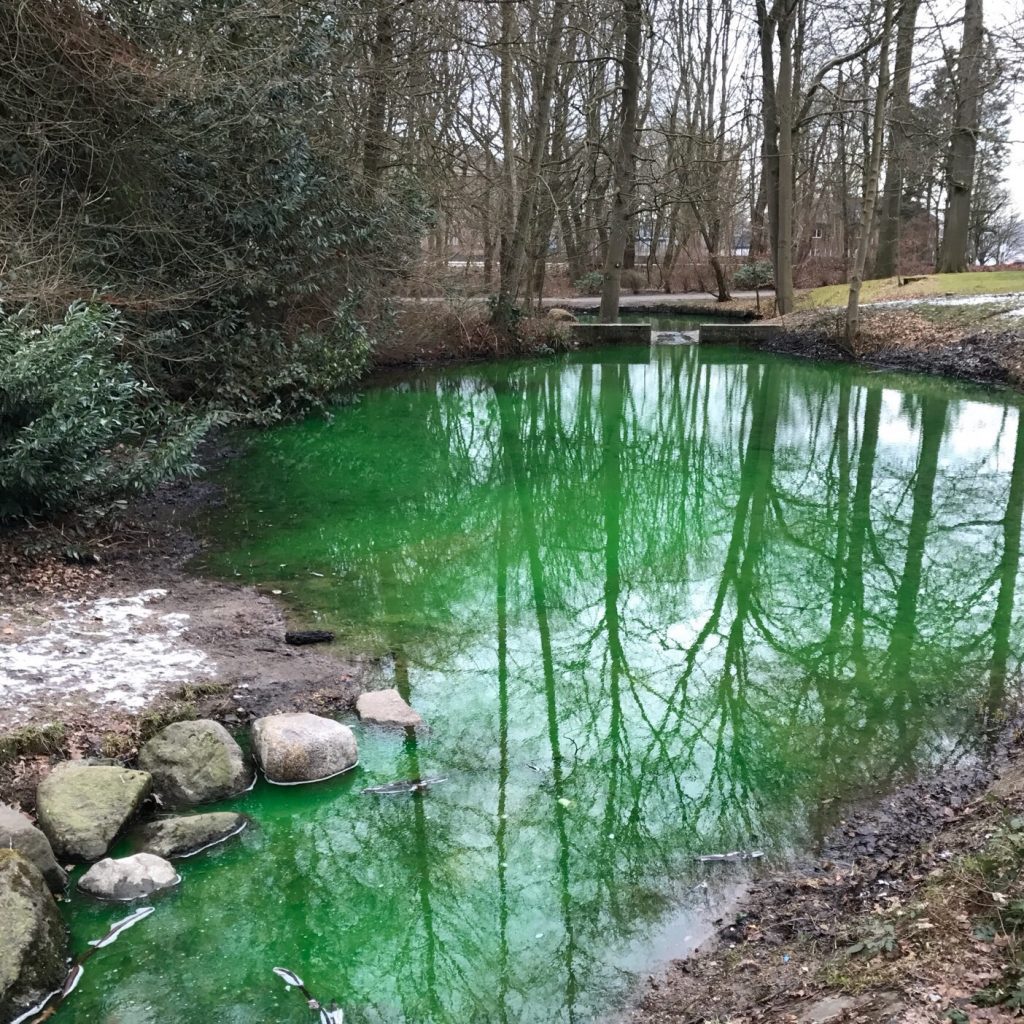
Neulich ging ich in der #forstbaumschule spazieren und siehe da: ein komplett grüner Teich! Sowas lässt mir dann ja keine Ruhe, bis ich herausgefunden habe, was da wohl passiert sein könnte. Stellt sich heraus, dass die @stadtwerke.kiel mit dem Farbstoff #uranin nach einem Leck in ihren Fernwärmeleitungen gesucht haben…
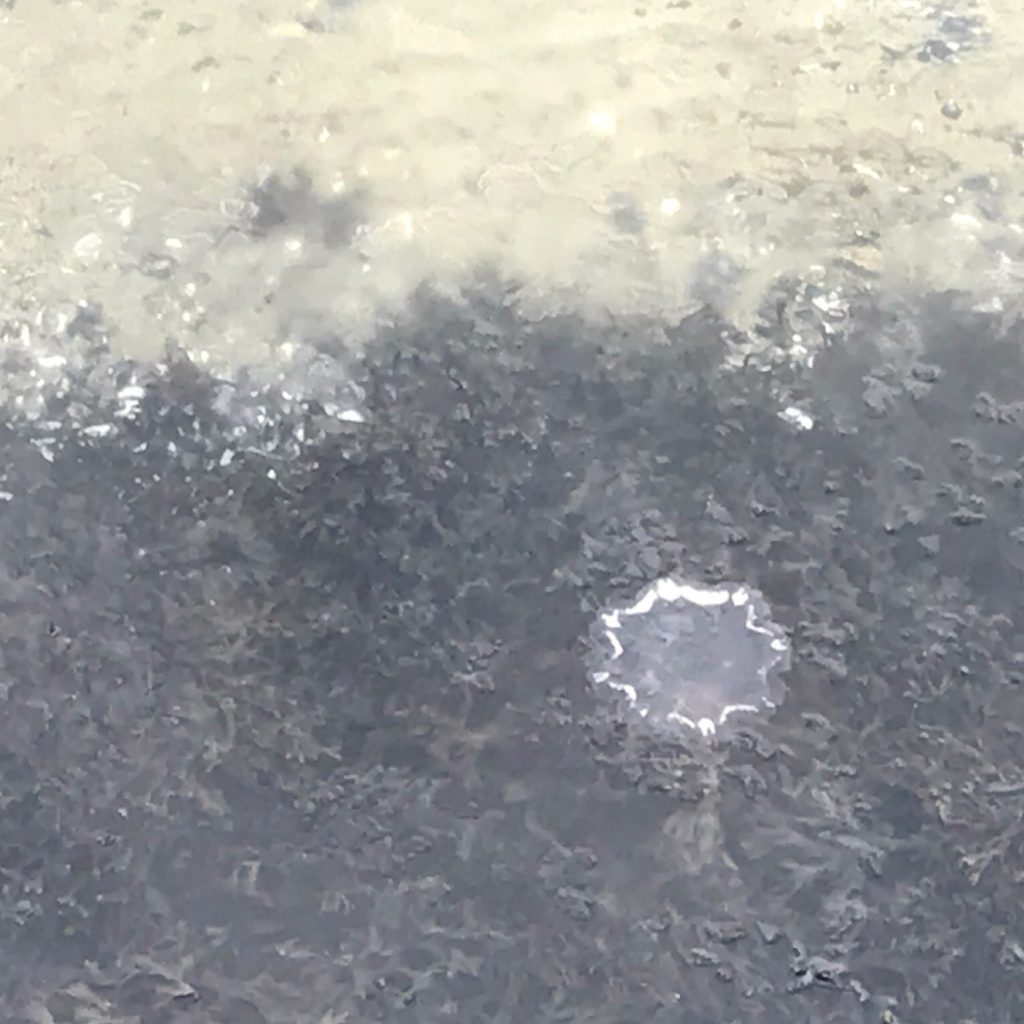
Die Feuerquallen von gestern sehen heute nicht mehr besonders gesund aus. Ob das daran liegt, dass um sie herum das Wasser anfängt zu gefrieren? Wenn man genau hinguckt, kann man im Foto winzig kleine Eisschöllchen erkennen.
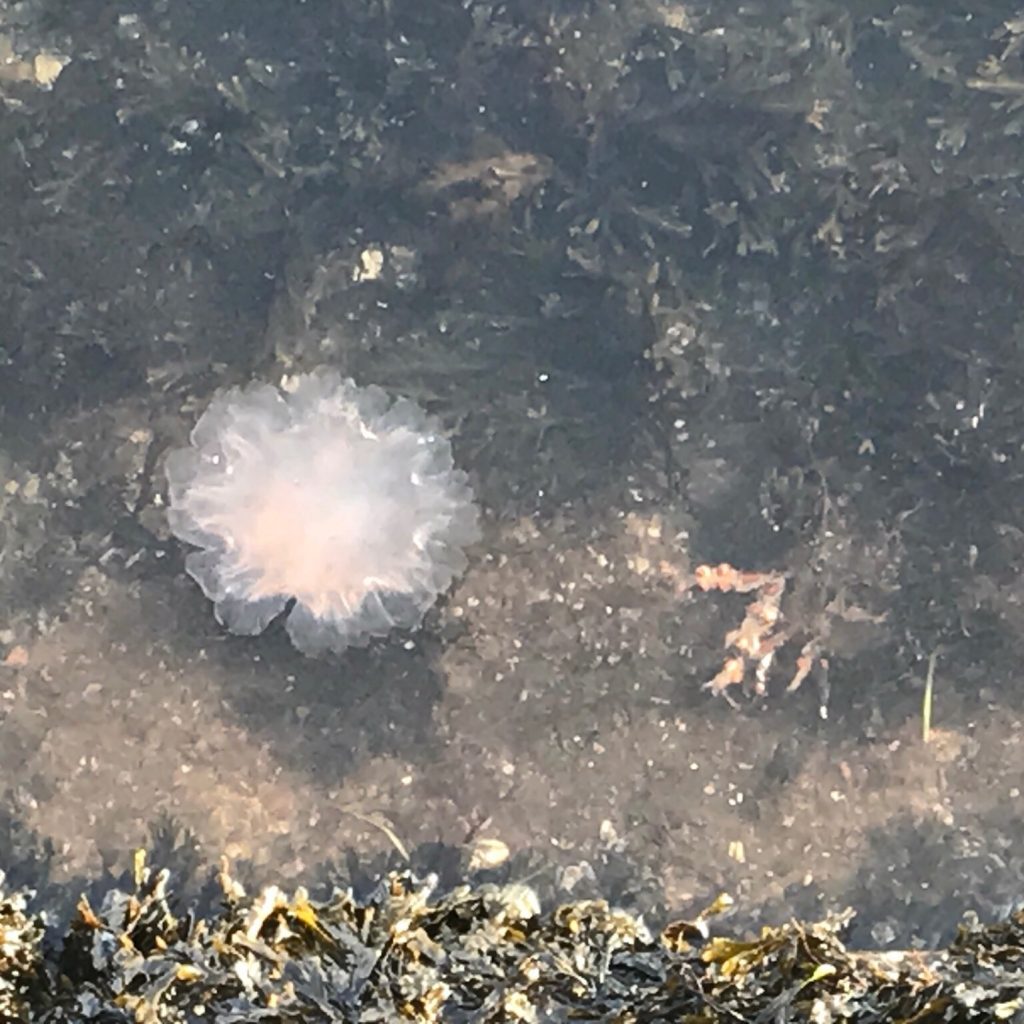
Wohin man guckt: Feuerquallen in der Kieler Förde! Was ist denn da los? Eigentlich mögen die Quallen die höheren Salzgehalte der Nordsee und des Atlantiks lieber als die der Ostsee, aber anscheinend sind sie mit einem Einstrom von salzigem Nordseewasser in die Kieler Bucht gespült worden. Als Plankton können sie ja nicht selbsttätig herumschwimmen… Zum Glück gehen momentan nur die ganz harten Leute in der Förde schwimmen, denn beim Berühren der Tentakel kann man sich schon mal fiese verbrennen.
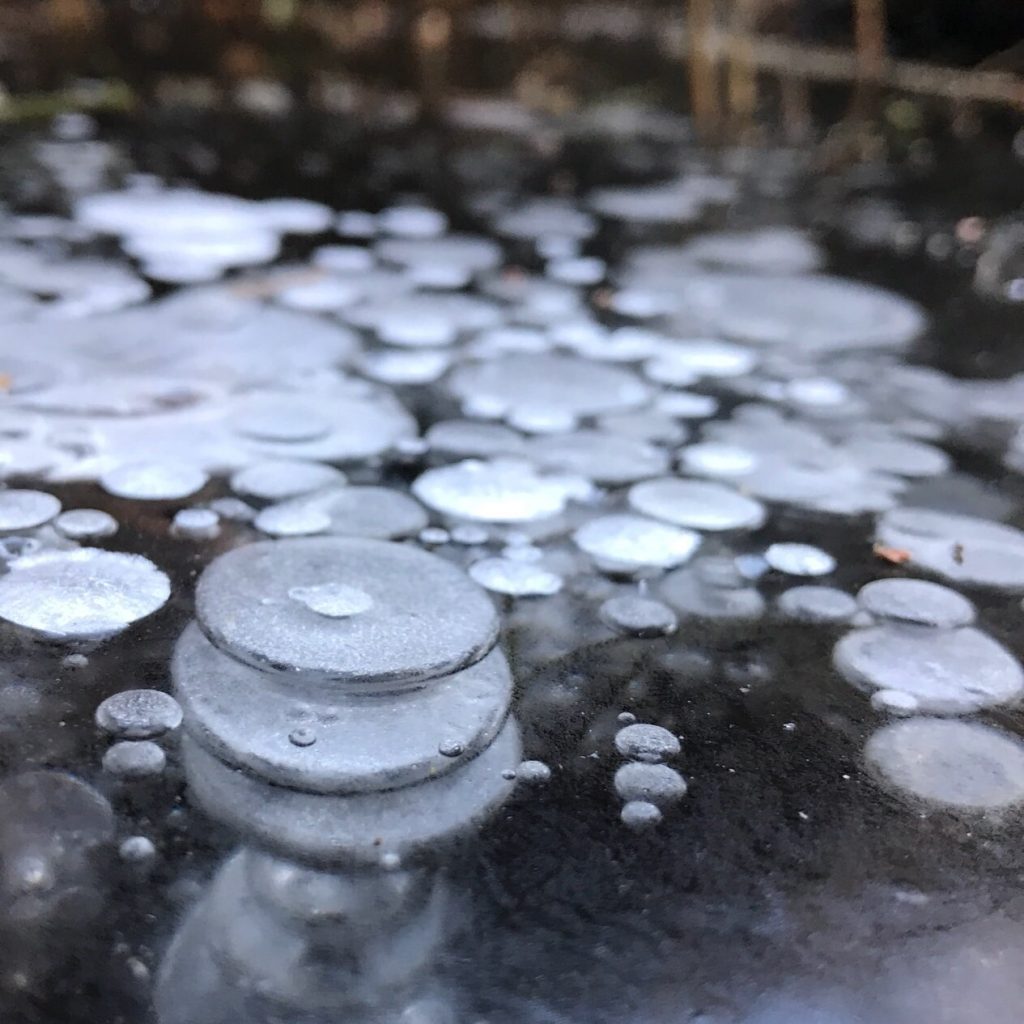
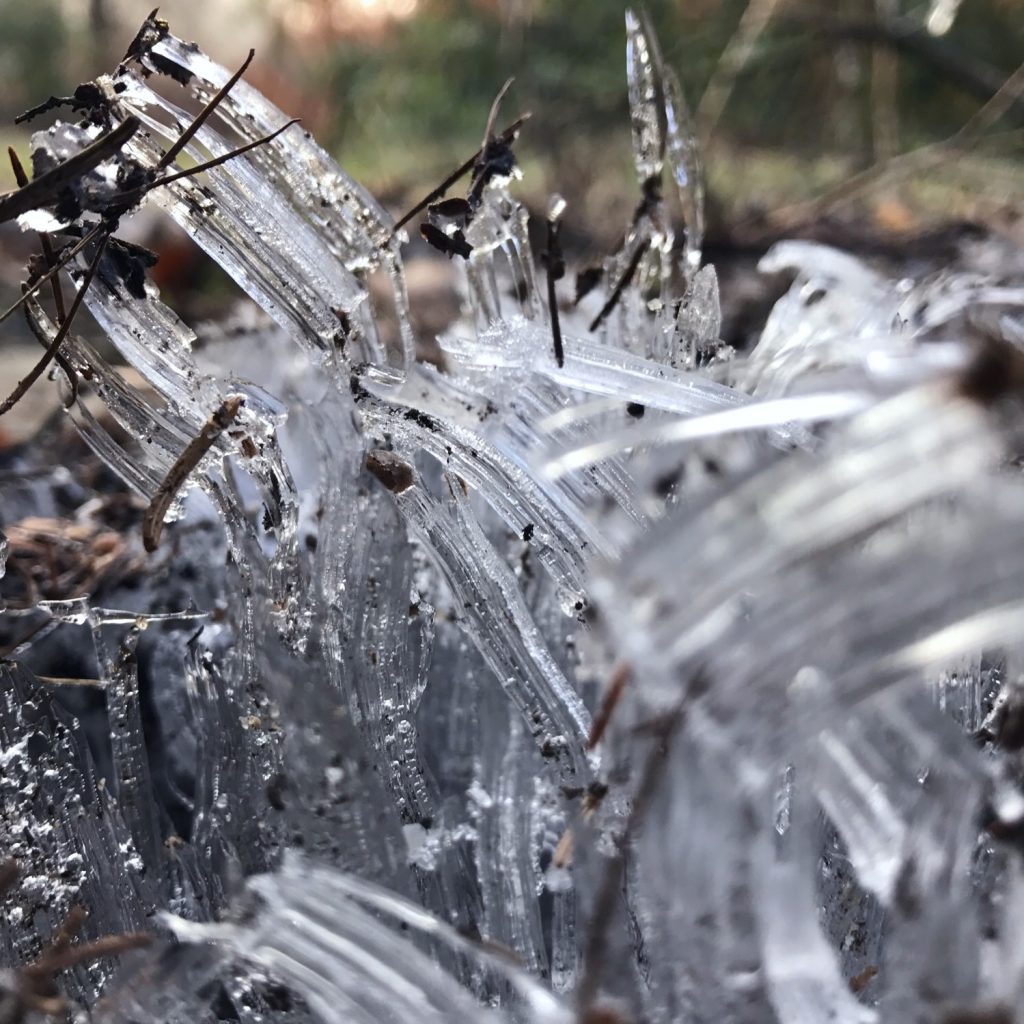
Wie auf meinem vorherigen Foto sieht man hier Kammeis. Es kann entstehen, wenn feuchter Boden durch sehr kalte Luft abgekühlt wird und beginnt, zu frieren. An der Oberfläche beginnen dann Eisnadeln, die nach oben geschoben werden, während unten immer neues Wasser durch die Kapillaren im Boden nachgeliefert wird und unten an die Nadeln anfriert. #kammeis #needleice #frostpillars #frostcolumns
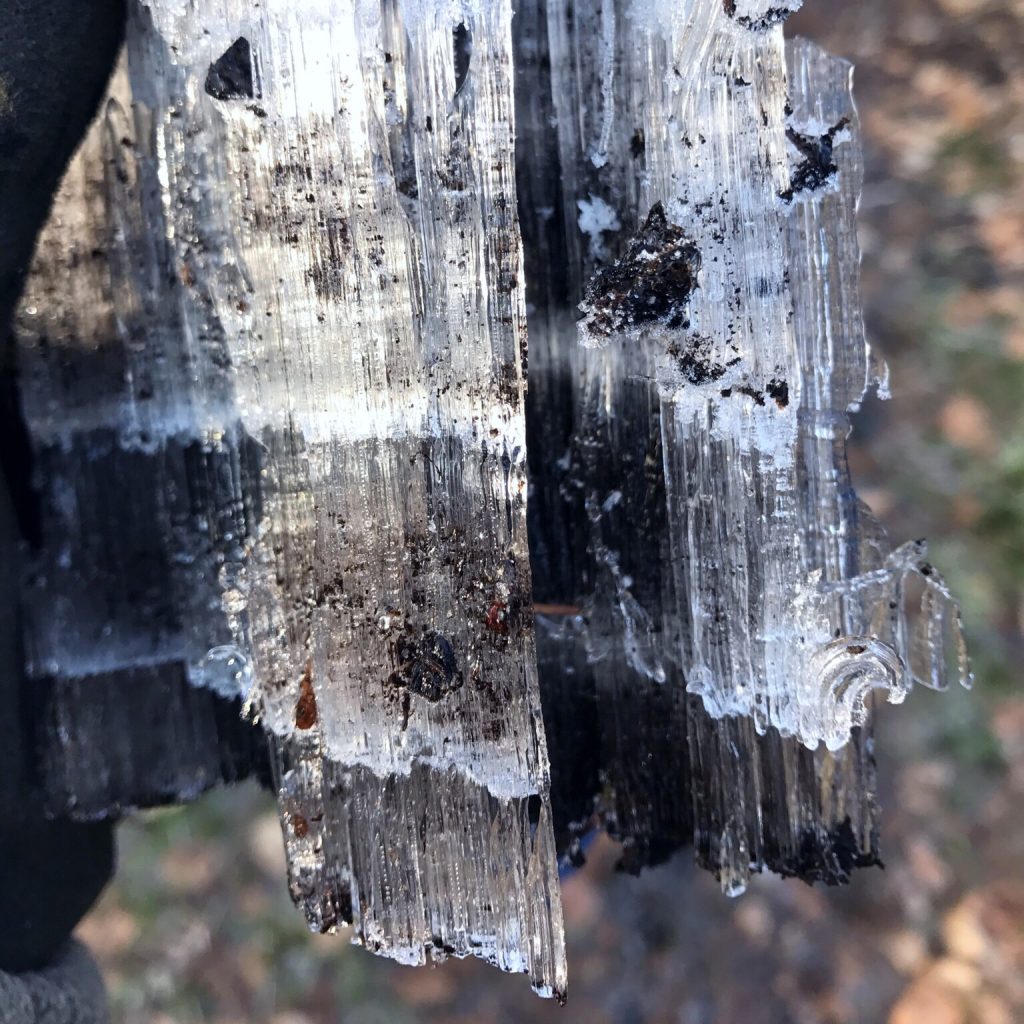
Was ich hier in der Hand halte, nennt man Kammeis. Es kann entstehen, wenn feuchter Boden durch sehr kalte Luft abgekühlt wird und beginnt, zu frieren. An der Oberfläche beginnen dann Eisnadeln, die nach oben geschoben werden, während unten immer neues Wasser durch die Kapillaren im Boden nachgeliefert wird und unten an die Nadeln anfriert. Im Foto sieht man, dass dieser Prozess über mehrere Tage stattgefunden hat: die helleren Schichten zeigen die Trennung zwischen zwei neuen Frostschüben an. #kammeis #needleice #frostpillars #frostcolumns